.
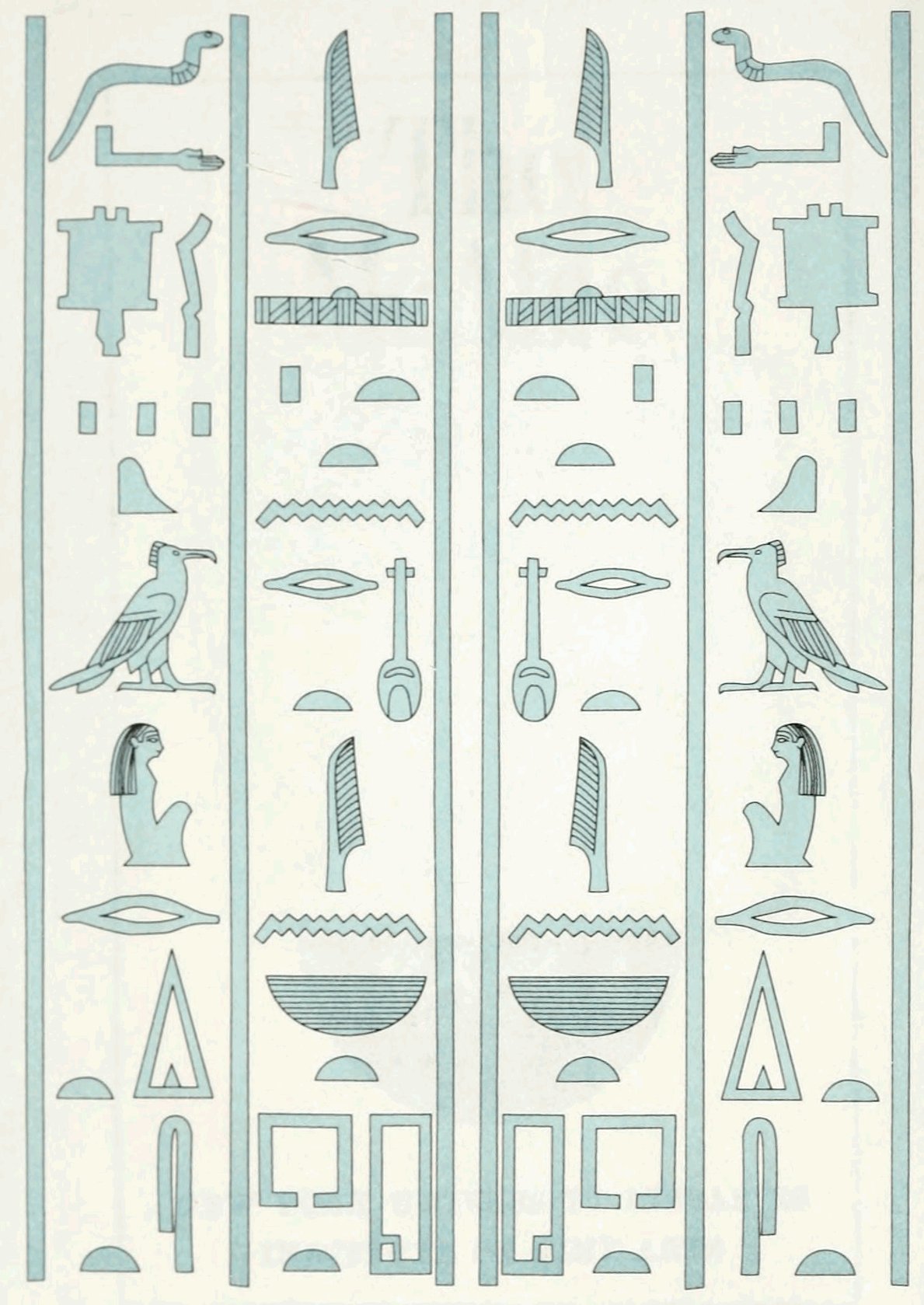
EGYPTIAN
DECORATIVE ART
A COURSE OF LECTURES
DELIVERED AT
THE ROYAL INSTITUTION
CONTENTS
| CHAPTER I | |
| SOURCES OF DECORATION | |
| PAGE | |
|---|---|
| EGYPTIAN TASTE FOR DECORATION | 1 |
| DECORATIVE WRITING OF HIEROGLYPHS | 3 |
| ORIGIN OF PATTERNS | 5 |
| PROBABILITY OF COPYING | 6 |
| GEOMETRICAL ORNAMENT | 9 |
| NATURAL ORNAMENT | 10 |
| STRUCTURAL ORNAMENT | 10 |
| SYMBOLIC ORNAMENT | 11 |
| CHAPTER II | |
| GEOMETRICAL DECORATION | |
| THE LINE AND ZIGZAG | 12 |
| THE SPOT | 15 |
| viTHE WAVE | 16 |
| THE SPIRAL | 17 |
| THE CONTINUOUS SPIRAL | 21 |
| SPIRAL SURFACE PATTERNS | 28 |
| QUADRUPLE SPIRALS | 31 |
| FRETS | 35 |
| GREEK SPIRALS | 38 |
| SPIRAL BORDERS | 40 |
| CHEQUERS | 44 |
| STITCH PATTERNS | 46 |
| CIRCLES | 47 |
| CHAPTER III | |
| NATURAL DECORATION | |
| FEATHERS | 50 |
| ROSETTES | 56 |
| DISC AND SPOT PATTERNS | 60 |
| LOTUS FLOWER | 62 |
| LOTUS BORDERS | 64 |
| LOTUS PLANT | 66 |
| LOTUS DEVELOPMENT | 68 |
| LOTUS, ASSYRIAN AND GREEK | 72 |
| LOTUS WITH PENDANT | 73 |
| PAPYRUS | 75 |
| LOTUS AND PAPYRUS COLUMNS | 76 |
| viiTHE PALM | 78 |
| THE VINE | 79 |
| THE CONVOLVULUS | 81 |
| THE THISTLE | 82 |
| GARLANDS | 82 |
| CAPTIVES | 85 |
| THE IBEX | 87 |
| BIRDS | 87 |
| STARS | 88 |
| GRAINING AND MARBLING | 89 |
| CHAPTER IV | |
| STRUCTURAL DECORATION | |
| STRUCTURAL FORMS SURVIVING | 91 |
| ROPE PATTERN | 92 |
| BASKET-WORK | 93 |
| WOODEN FRAMING | 94 |
| PANELLING | 95 |
| SLOPING WALLS | 96 |
| TORUS ROLL | 97 |
| PALM CORNICE | 98 |
| PAPYRUS CORNICE | 101 |
| BINDING PATTERNS | 103 |
| viii | |
| CHAPTER V | |
| SYMBOLIC DECORATION | |
| THE URAEUS | 107 |
| THE DISC AND WINGS | 108 |
| THE HORNS | 110 |
| THE VULTURE | 111 |
| THE SCARAB | 111 |
| THE LION | 112 |
| THE GODDESS MAAT | 114 |
| THE GODDESS HATHOR | 114 |
| THE GOD BES | 115 |
| HIEROGLYPH SYMBOLS | 116 |
| CAPTIVES | 122 |
| INDEX | 123 |
ABBREVIATIONS
The shading of the figures is according to heraldic colours:
 red,
red,  blue,
blue,  green,
green,  purple,
purple,  yellow
yellow
CHAPTER I
THE SOURCES OF DECORATION
In dealing with the subject of decorative art in Egypt, it is needful to begin by setting some bounds to a study which might be made to embrace almost every example of ancient work known to us in that land. The Egyptian treatment of everything great and small was so strongly decorative that it is hard to exclude an overwhelming variety of considerations. But here it is proposed to limit our view to the historical development of the various motives or elements of decoration. The larger questions of the æsthetic scheme of design, of the meaning of ornament—symbolic 2or religious, of the value and effect of colour, of the relations of parts, we can but glance at occasionally in passing; in another branch, the historical connection of Egyptian design with that of other countries, the prospect is so tempting and so valuable, that we may linger a little at each of these bye-ways to note where the turning occurs and to what it leads. As I have said, all Egyptian design was strongly decorative. The love of form and of drawing was perhaps a greater force with the Egyptians than with any other people. The early Babylonians and the Chinese had, like the Egyptians, a pictorial writing; but step by step they soon dropped the picture altogether in favour of the easier abbreviation of it. The Egyptian, on the contrary, never lost sight of his original picture; and however much his current hand altered, yet for four or five thousand years he still maintained his 3true hieroglyphic pictures. They were modified by taste and fashion, even in some cases their origin was forgotten, yet the artistic form was there to the very end.
But the hieroglyphs were not only a writing, they were a decoration in themselves. Their position was ruled by their effect as a frieze, like the beautiful tile borders of Cufic inscription on Arab architecture; and we never see in Egypt the barbarous cutting of an inscription across figure sculptures as is so common in Assyria. The arrangement of the groups of hieroglyphs was also ruled by their decorative effect. Signs were often transposed in order to group them more harmoniously together in a graceful scheme; and many sounds had two different signs, one tall, another wide, which could be used indifferently (at least in later times) so as to combine better with the forms which adjoined them. In short, the 4Egyptian with true decorative instinct clung to his pictorial writing, modified it to adapt it to his designs, and was rewarded by having the most beautiful writing that ever existed, and one which excited and gave scope to his artistic tastes on every monument. This is but one illustration of the inherent power for design and decoration which made the Egyptian the father of the world’s ornament.
In other directions we see the same ability. In the adaptation of the scenes of peace or of war to the gigantic wall surfaces of the pylons and temples; in the grand situations chosen for the buildings, from the platform of cliffs for the pyramids at Gizeh, to the graceful island of Philæ; in the profusion of ornament on the small objects of daily life, which yet never appear inappropriate until a debased period;—in all these different manners the Egyptian showed a 5variety of capacity in design and decoration which has not been exceeded by any other people.
The question of the origination of patterns at one or more centres has been as disputed as the origination of man himself from one or more stocks. Probably some patterns may have been re-invented in different ages and countries; but, as yet, we have far less evidence of re-invention than we have of copying. It is easy to pre-suppose a repeated invention of designs, but we are concerned with what has been, and not with what might have been. Practically it is very difficult, or almost impossible, to point out decoration which is proved to have originated independently, and not to have been copied from the Egyptian stock. The influences of the 6modes of work in weaving and basket-work have had much to do with the uniformity of patterns in different countries; apparently starting from different motives, the patterns when subject to the same structural influences have resulted in very similar ornaments. This complicates the question undoubtedly; and until we have much more research on the history of design, and an abundance of dated examples, it will be unsafe to dogmatise one way or the other. So far, however, as evidence at present goes, it may be said that—in the Old World at least—there is a presumption that all the ornament of the types of Egyptian designs is lineally descended from those designs. Mr. Goodyear has brought so much evidence for this, that—whether we agree with all his views or not—his facts are reasonably convincing on the general descent of classic ornament from Egyptian, and of Indian and 7Mohammedan from the classical, and even of Eastern Asian design from the Mohammedan sources. A good illustration of the penetrating effect of design is seen in a most interesting work on the prehistoric bronzes of Minusinsk in Central Asia, near the sources of the Yenesei river, and equidistant from Russia and from China, from the Arctic Ocean and from the Bay of Bengal. Here in the very heart of Asia we might look for some original design. But yet it is easy to see the mingled influences of the surrounding lands, and to lay one’s finger on one thing that might be Norse, on another that might be Chinese, or another Persian. If, then, the tastes of countries distant one or two thousand miles in different directions can be seen moulding an art across half a continent, how much more readily can we credit the descent of design along the well-known historical lines of intercourse. The same thing on a 8lesser scale is seen in the recent publication of the prehistoric bronzes of Upper Bavaria; in these the designs are partly Italic, partly Mykenaean. If forms were readily re-invented again and again independently, why should we not find in Bavaria some of the Persian or Chinese types? Nothing of the kind is seen, but the forms and decoration are distinctly those of the two countries from which the ancient makers presumably obtained their arts and civilisation. Yet again, to come to historical times, the elegant use of the angle of a third of a right angle so generally in Arab art, is very distinct and characteristic. Yet if patterns were continually re-invented, how is it that no one else hit on this simple element for thousands of years? The very fact that the locality and date of an object of unknown origin can be so closely predicted by its style and feeling in design, is the best proof how continuous is the history and evolution 9of ornament, and how little new invention has to do with it—in short, how difficult it is to man to be really original.
Now we can see a source for most of our familiar elements of design in the decoration which was used in Egypt long before any example that is known to us outside of that land. And it is to Egypt then that we are logically bound to look as the origin of these motives. If, then, we seek the source of most of the various elements of the decoration which covers our walls, our floors, our dishes, our book-covers, and even our railway stations, we must begin by studying Egypt.
As our object is the history and evolution of the various elements of decoration, we may classify these elements under four divisions. There is the simplest geometrical ornament of lines and spirals and curves, and 10of surfaces divided by these into squares and circles. There is the natural ornament of copying feathers, flowers, plants, and animals. There is structural ornament which results from the structural necessities of building and of manufacture: these often result in the perpetuation of defects or copies of defects, like the circle stamped in the plain end of meat tins which is made to imitate the circular patch soldered on to the other end, so trying to establish a balance of appearance. Many architectural devices and difficulties are perpetuated for us in this way long after the original purpose has passed away; such as the cylindrical bosses projecting from the walls in Moslem architecture, which imitate the projecting ends of pillars torn from ruins and built into the wall, though rather too long for the position. The origin and the imitation can be seen side by side at Jerusalem. Structural ornament is therefore 11often of the greatest historical value as pointing to a condition of things that has since vanished.
Lastly, there is symbolic ornament. Some now claim most decoration as having some symbolic or religious meaning; of that I shall say nothing, as it is but an hypothesis. But there is no question of the symbolical intention of many constantly repeated ornaments in Egyptian work, as the globe and wings, the scarab, or the various hieroglyphs with well-known meanings which are interwoven into many designs.
CHAPTER II
GEOMETRICAL DECORATION
The Line.
One of the simplest and the earliest kinds of ornament that we find is the zigzag line, which occurs on the oldest tombs, 4000 B.C. So simple is this, that it might be supposed that every possible variety of it would be soon played out. Yet, strange to say, two of the simplest modifications are not found till a couple of thousand years after the plain zigzag had been used. The wavy line in curves instead of angular waves is not found till the XVIIIth dynasty, or about 1500 B.C.; while the zigzag with spots in the spaces 13is equally late, and is generally foreign to Egypt.

1.—VI. dyn., L.D., II. 98.

2.—IV. dyn., Mery, Louvre.

3.—V. dyn., Ptah-hotep, Perrot XIII.
The plain repeated zigzag line is used down to late times, but generally with variety in colour to give it interest. From the earliest times this was symmetrically doubled, so as to give a row of squares with parallel borders; or with repeated zigzag borders in alternate light and dark colours. This same type lasted onward to the XIXth dynasty (belt Ramessu II. C.M.X.), and is found, with the addition of spots in the outer angles, in the foreign dress of Shekh Absha, at Benihasan, in the XIIth dynasty.

4.—Prisse, Art. 84.

5.—L.D., II. 130.
A later stage was to repeat the squares with varieties of colour; and also to introduce details into the squares, and so make them compound patterns, as in the XVIIth dynasty at El Kab, where the sequence of the blue, green, and red lines makes a brilliant effect from these simple elements. Not only a square, but also a hexagon, was worked into the same design. This, from the nature of it, suggests a rush-work screen, and probably it was plaited with rushes in three directions, and hence the production of this particular angle. The previous zigzag patterns all suggest weaving; and in some in Ptah-hotep’s tomb (Vth dyn.) closely woven 15and complex zigzag patterns are shown which are evidently copied from textiles, as we shall see further on in the chequer patterns.

6.—XII. dyn. Amu dress.

7.—XVIII., Keft dress. C.M. cxcl.

8.—XX. Vase, C.M. cclix.
The use of spots for filling in corners was foreign to the Egyptian. We first find it in the garments of the Amu, or people of northern Arabia, in the XIIth dynasty. Till then a spot is never seen, except for the centre of a square; but the Amu dresses are covered with spots in every space, and even along the bars and stripes of colour. The same is seen on the later dresses of the Amu in the XIXth dynasty, and also in the dress of the Phœnicians, or Keft people. It recurs on the foreign vases probably brought in from the Aegean; and it is only found in Egyptian products 16during the XVIIIth dynasty, when foreign fashions prevailed, though it is but rare then. Hence we may fairly set aside this use of spots as a foreign or Asiatic element, akin to the filling in of spaces on early Greek vases with rosettes and other small ornaments.

9.—XVIII., P. I. xvii. 7.

10.—XVIII. Vase, R.C. lvii.
The zigzag line only became changed into a rounded wavy line in the later time of the XVIIIth dynasty. This probably results from the earlier patterns being all direct copies of textiles which maintained rectilinear patterns; but when the same came to be used on pottery (as above), or on metal work (shield border, L.D. iii. 64), then curves were readily introduced. On a golden bowl repeated waves are shown, deepened so as to receive further figures.
The Spiral.
The spiral, or scroll, is one of the greatest elements of Egyptian decoration; it is only second to the lotus in importance, and shares with that the origination of a great part of the ornament of the world. The source of the spiral and its meaning are alike uncertain. It has been attributed to a development of the lotus pattern; but it is known in every variety of treatment without any trace of connection with the lotus. It has been said to represent the wanderings of the soul; why, or how, is not specified; nor why some souls should wander in circular spirals, others in oval spirals, some in spirals with ends, others in spirals that are endless. And what a soul was supposed to do when on the track of a triple diverging 18spiral, how it could go two ways at once, or which line it was to take—all these difficulties suggest that the theorist’s soul was on a remarkable spiral.

11.—F.P. coll.

12.—F.P.

13.—F.P.
The subject of spirals fall into two groups. The older group by far are the scarabs, which contain spirals on a limited and small field; the other group are those continuous patterns on ceilings, furniture, &c., which are capable of indefinite extension by repetition. As the scarabs are far the older examples, there is a presumption that spirals may have even originated on scarab designs; and the hesitating and simple manner of the oldest instances on scarabs indeed seems as if the engravers were merely filling a space, and not copying any well-known pattern. The earliest that can be certainly dated is one of Assa, of the Vth dynasty, on which a bordering line is interrupted at the ends and turned in to fill the space on either side of the name. From the cramped way in which this is done, and the want of uniformity in the spirals, it seems as if no regular pattern were in view, but only the need of avoiding an unsightly gap in the design. We next see spirals used in the same way to fill up at the sides of the inscription on the scarabs of Pepy, without any attempt to connect them into a continuous pattern; and on the scarabs of Ma·abra, probably soon after, the same loose spirals are seen thrown in to fill up. In none of these cases is the ornament anything but the means of supplementing the required inscription; nothing is arranged for the sake 20of it, and it is treated as a mere afterthought. Nor is it until the XIIth dynasty that any continuous spiral design can be dated. For over a thousand years, then, the spiral is only to be found as an accessory on scarabs, a fact which strongly suggests that it originated in this manner.
Before describing spirals further, it is needful to settle some definite names for their varieties. Where the lines are coiled closely in a circular curve, as in Assa’s scarab, they may be termed coils; where lengthened out, as in Pepy’s, we may term them hooks; where lengthy in the body between the turns, as in Ma·abra’s, they are rather links. Where the line is broken at each spiral, as in all the above, it is a chain of spirals; but where the same line is maintained unbroken throughout it is a continuous spiral, and these are found in all varieties of coils, hooks, or links. 21Sometimes the continuous line has separate ends, but more usually it is endless, returning into itself. These terms will suffice to distinguish the varieties, and enable us to speak of a spiral with definiteness.

14.—Louvre.

15.—Ghizeh.
These detached spirals continued in use in the XIIth dynasty, generally as loose links, often not hooking together, as in this of Usertesen II. In the XVIIIth dynasty this is still found as a general surface ornament on the boat covers of Hatshepsut at Deir al Bahri and on the base of a Kohl vase in the Ghizeh Museum.
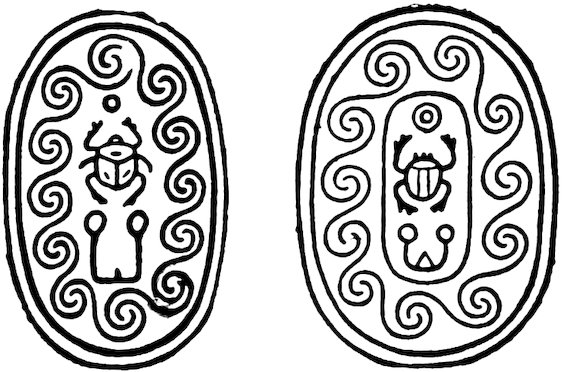
Fig. 16. F.P. coll. Fig. 17.
But the spiral was developed, apparently under Usertesen I., into a chain of coils, which are drawn with great beauty 22and regularity. Such care indicates that the design was a novelty, which was not yet stereotyped and reproduced as a matter of course. In no later reign were spirals ever so beautifully and perfectly executed. This type was revived under Amenhotep II. (H. S. 1097). In about the XIIth dynasty it was combined with the lotus in perhaps the most perfect design that remains on any scarab—a continuous coil with flowers and buds in the spaces.

18.—Turin.

19.—F.P.
But it was felt that the spirals all round occupied too much of the field, so the top and bottom were left free for inscribing, and the ornament was limited to the sides, as in this chain of hook pattern of Usertesen I. This design, with the line continued around the top as well as the base, was the staple 23decoration of the private scarabs of the XIIth-XIIIth dynasties, many of which are of great beauty. Both types are found, but the hook pattern is more usual than the coils.
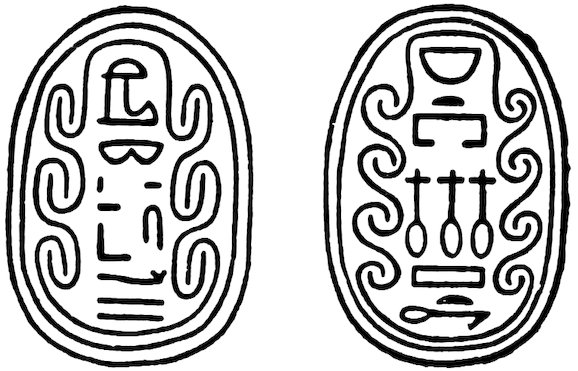
Fig. 20. F.P. coll. Fig. 21.
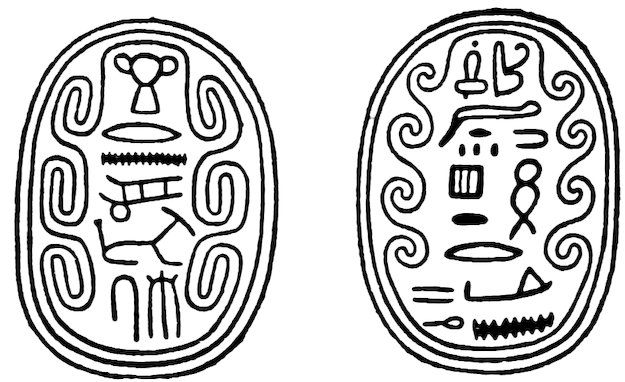
Fig. 22. F.P. coll. Fig. 23.
In the finest work, however, the line is made endless, a single continuous line forming the whole pattern, as in the endless hook pattern of Setmes, and the endless coil pattern of Ptaherduen.

24.—Paris.

25.—F.P.
In the few spiral scarabs of later times the pattern is not only placed at the sides, but is carried all round, as we see in that of 24Amenhotep I. and one of Ramessu II., which latter is the latest spiral pattern known on scarabs.

26.—F.P. coll.
The long links were seldom used in continuous patterns around scarabs, as in this, but were more usually employed for independent spiral patterns without any inscriptions.

27.—F.P. coll.

28.—K. x. 50.

29.—I. viii. 69.

30.—K. x. 28.

31.—K. x. 40.
After serving as adjuncts to inscriptions, the spirals became elaborated as sole patterns. These are at first a few simple coils, as on one which, from the side pattern, can be dated 25to about the VIIIth dynasty. These, when elaborated with more coils or links, sometimes developed to great length.

32.—K. x. 17.

33.—F.P.

34.—I. x. 176.
Such patterns required but little ingenuity, and it is rather in the design of continuous spirals that the Egyptian showed his skill. The problem was how to arrange a number of coils in a symmetrical system uniformly covering the surface of the scarab, and yet to connect them in a true series. This was done in various ways, usually by introducing long loop lines around the edge. One of the simplest type is— In another a cross pattern is formed which is entirely of C coils, like frequent patterns at Mykenae.

35.—F.P.

36.—F.P.

37.—F.P.
Others fill up by establishing a repeating 26pattern, which might be indefinitely multiplied, as — and the difficulty is avoided on a large silver scarab of early date by shortening the links to allow of the connecting line passing the ends.
This difficulty of designing good covering patterns out of true continuous lines probably led to the evasion of introducing false links. Thus what would otherwise have been an opening in the middle was barred across.

38.—I. x. 158.

39.—K. x. 27.

40.—K. x. 48.

41.—F.P.

42.—F.P.
Some beautiful effects were obtained by 27this false barring, which does not, at first sight, catch the eye, as in these two examples.

43.—F.P.
In the latter, two complete lop-sided spiral groups are joined by long false links around the outside. Another favourite device which often occurs is also compounded of lop-sided groups, or rather of a cross group, like Fig. 43, with four false links joining in the middle.

44.—I. x. 144.

45.—I. x. 155.

46.—F.P.

47.—Turin.
Some other devices did not profess to cover the whole field, as in Figs. 44 and 45; and sometimes two separate 28lines of design were superposed, a single element of the same design being found as late as Tahutmes III.
The spiral had thus been greatly developed as a detached ornament for a small surface; but in architecture and furniture it was required as a continuous decoration on borders and on large surfaces. Hence its development was in many ways different, and—so far as we know—later by a whole cycle of history than the development on the scarabs. On those small objects it started in the Vth dynasty, became fully elaborated in the XIIth, is common in the XIIIth, and only very occasionally found in the XVIIIth, disappearing altogether in the XIXth. On walls and furniture it is rare in the XIIth dynasty, becomes usual in the XVIIIth, flourishes in the XIXth 29and XXth, and is decadent in the XXVIth.

Fig. 48.
The simplest form in which it is found is as a chequered pattern series of S spirals, apparently on cloths thrown over boat cabins. On Hatshepsut’s boat the spirals are close together (Duem. XXI.); but rather later, on the boat of Neferhotep, they are spread with chequers of red and blue between them (W.M.C. lxvii.).

Fig. 49.
About the same period they appear as a continuous coil pattern in relief on the columns of the harim well at Tell el Amarna. The spiral in relief being in yellow, it probably was copied from a jewellery pattern in which a strip of gold was twisted into spirals, and the spaces filled with squares 30of coloured stones or pastes, judging from the analogy of the inlaid capitals. This example being earlier than most of the spiral decorations of surfaces may thus open our eyes to the meaning of some such designs; and, in general, a close continuous coil returning on itself may well be a copy of a strip of sheet metal, doubled, and rolled up.

50.—P. 85. I.
The next stage is where continuous lines of spiral patterns are placed side by side, and other patterns developed in the spaces between them. Sometimes the intervening patterns become so complex as to overshadow the mere spirals, as in the splendid 31ceiling of Neferhotep, in the XVIIIth dynasty. And in this the far more complex quadruple spiral begins to appear, as we shall see presently.

51.—P. 85.

52.—C.M. cclv.
The lines of spirals were not only placed parallel, but were also crossed. For some reason this type was never well developed, but remained one of the coldest and most mechanical of all, looking in the later stage of the XXVIth dynasty like a most debased wall paper.
But the glory of Egyptian line decoration was in the quadruple spiral, of which the most elementary example is on a boat cover as late as the 32XXth dynasty (Ramessu IV.); though it has passed through this stage long before that time—if indeed this may not be regarded as a degraded simplification of it. It is also sometimes rhombic in plan.

53.—P. 86.

54.—XIIth dyn. R.C. lxxii.
From this was developed a peculiar pattern by the omission of the lines which define the spirals, thus reducing it to a system of rows of hollow-sided quadrangles without any apparent connection.
The main development of the quadruple spiral was with rosettes or lotus filling the hollow squares.
This became a stock subject with the 33Egyptian, and from thence a main pattern in other lands. The filling in was either a flower pattern or a rosette, which might be either a flower or a leather pattern, as we shall notice further on.

Fig. 55.

56.—P. 86.
The insertion also became more complex, four lotus flowers being placed in each angle of the hollow square; and the spirals being more heavily developed, in order to gain enough space for complexity in the squares between them. Such a system could hardly be carried further, but reached its limits; like the limit of size in the Great Hall of Karnak, where the columns occupy too large an area in proportion to the clear space.
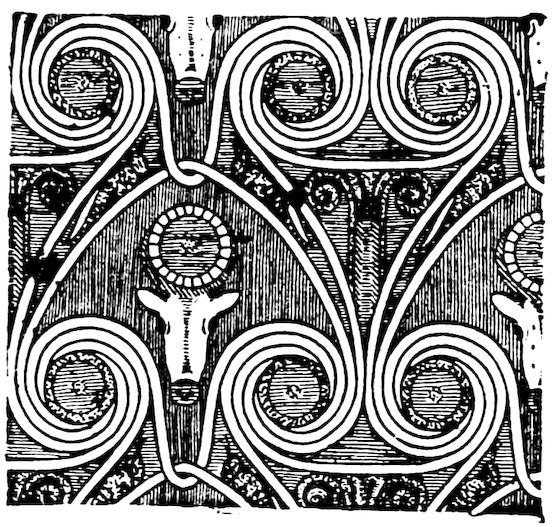
57.—P. 83.
In another direction, however, the spiral blossomed further, in the parallel lines of spiral pattern. These became developed by introducing link lines so as to form a quintuple spiral, which was further complicated by lotus flowers and buds in the hollows and recesses.
In this direction, again, the Egyptians had reached the limit beyond which more detail would be merely confusing. By careful use of colour to separate the various parts, these complex patterns remain clear and pleasing in spite of their richness of detail.
The quadruple spiral had, however, another development, of C links, which is rather too formal to be beautiful, and lacks the flamboyant grace of the chains of 35spirals. Still it has a simple dignity, related to the scarab spirals rather than the flowing surface patterns. This became formalised into a torturing kind of design, which can only be described as “cursedly ingenious.” By simplifying the previous pattern, a wave was invented which was equal in each direction, and four of these were crossed in a manner which nothing but bold colouring could make intelligible.

58.—P. 85.
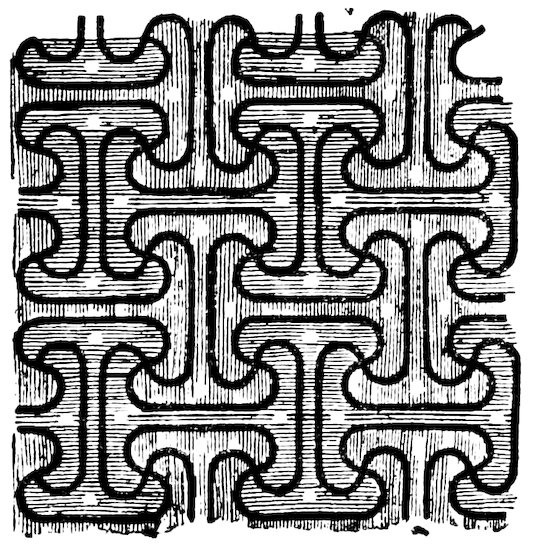
59.—P. 83.
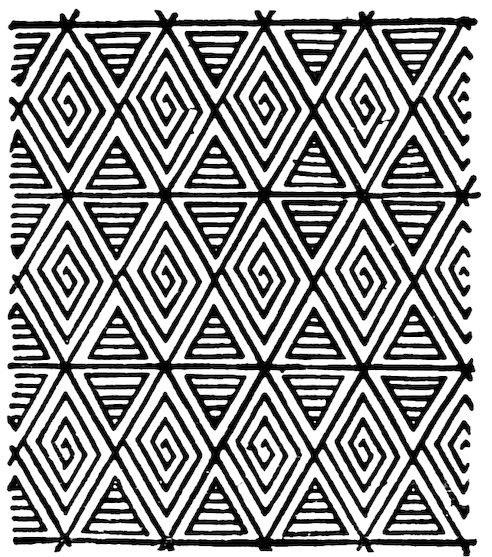
60.—L.D. II. 57.
The fret patterns are all modifications of corresponding spirals. The cause of such change is obviously the influence of weaving. As early as the Vth dynasty we find a fret of rhombic form in basket-work in the screen behind the figure of Ptah·bau·nefer, at Gizeh. The angles show that the plaiting was in three directions, as we saw in the basket-work pattern at Benihasan (Fig. 3). But frets in general are very rare until a late period, and they doubtless depend on the adaptation of spirals to textiles. We see no trace of the fret in the Mykenaean art, the spiral there being figured on stone or metal, while the women wore flounced dresses with scale pattern. But in the pre-Persian age fret pattern weaving in borders was the standard design, as we see on the coloured robes of the Parthenon 37statues; and immediately after that the stiffest of square frets swarms over Greek art, to the exclusion of the graceful spirals and scroll borders.
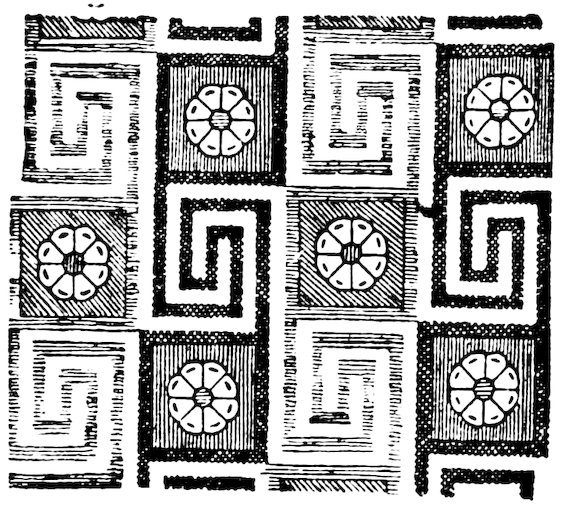
61.—P. 82.
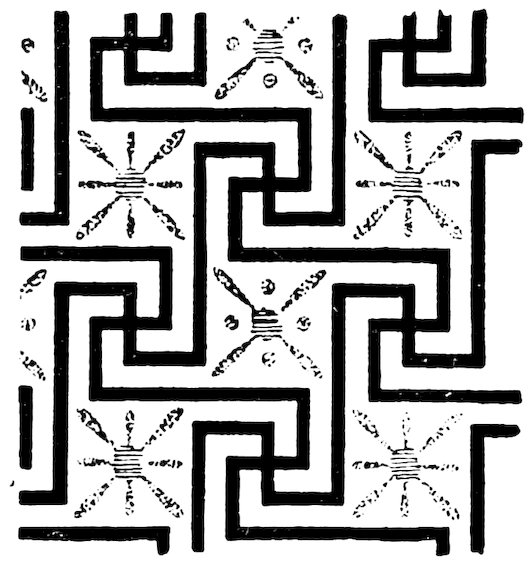
62.—P. 83.

63.—P. 83.
The chains of links were copied in the fret pattern with no difference except in squaring up the curves. The same is true of the quadruple spirals, which appear likewise modified; and this change seems to have led to another simplified form, which is on the 38same idea as the torturing design (Fig. 59), but which is less ingenious, and is still possible as an ornament.

64.—Schuck. 256.
So far we have viewed only the course of Egyptian design, nor can we travel far outside of it within these pages. Moreover, as it is dated before any other such decoration in other countries, it is well to view its course as a whole without confusing it with the various fragments borrowed from it by other lands. Yet we may well turn now to see the beginning of the course of European decoration at Mykenae, and observe its close contact with that of Egypt. The spiral is the main element of prehistoric decoration in Greece; the parallel chains of links occur almost exactly as we have already seen them in the pattern 39of Neferhotep, but omitting the inner details added in the spaces.
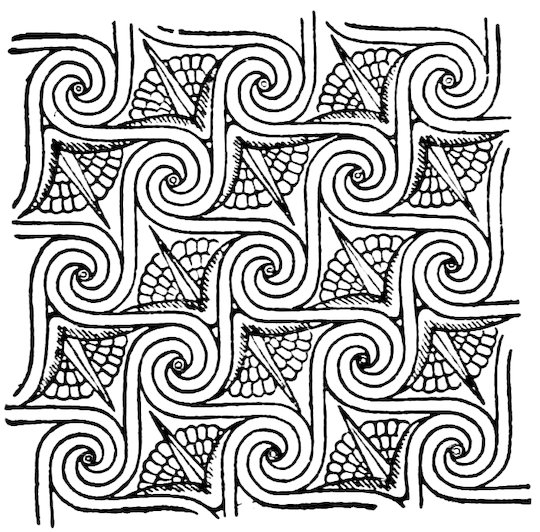
65.—Schuck. 290.
The quadruple spiral is splendidly shown in the ceiling of Orchomenos, with a lotus flower in each space; also as a simpler form without any filling in of the squares on the grave stele (Schuck. 146). While even the ox head with a rosette between the horns, in the grand quintuple spiral pattern (Fig. 57), is strangely paralleled by an ox head of silver with a large rosette on the forehead found at Mykenae (Schuck. 248).
In observing these equivalents it must be noted that whole patterns with their detail are taken over complete from Egypt. There are none of the series of intermediate steps which we have traced in the 40mother country; and where a simpler form occurs it is known to be later, the grave steles being after the age of the great ceiling. Thus there is the surest sign of a borrowed art, apart from the facts of the exact resemblances we have noted. Of course the Mykenaean designs are mostly influenced by the taste of the race. Many of them are strongly European, and might be of Celtic or Norse work, as has been shown by Mr. Arthur Evans; but the source of the designs lies in the two thousand years’ start which Egypt had before Europe awoke.

Fig. 66.

67.—R.C. lvii.

68.—P. 97. 105.

69.—R.C. lxii.
A separate form of the spiral pattern is that used for borders, otherwise called the wave or maeander, which merged into the guilloche. Although the chain of coils on the scarab borders in the XIIth dynasty may be regarded as a wave border, yet no example is known of this border on other objects until the XVIIIth dynasty. At that time it appears as often on foreign objects as on Egyptian, and the only instance of the guilloche is on foreign dress. Hence this development of the spiral idea may well be due more to the Aegean civilisation than to that of Egypt. This will agree with the occurrence of the guilloche on black pottery from Kahun, which class, wherever it can be dated, is found to belong to the XIIth-XIIIth dynasty. The metal vases shown on the monuments of the XVIIIth-XXth dynasties are mostly foreign tributes, and on them the wave border is 42common, merging into a twisted rope border which is also found—though rarely—on scarabs of the Middle Kingdom.

70.—R.C. lvii.

Fig. 71.

Fig. 72.
In Egyptian use this border is seldom found. A box in the Louvre had a line of long links; and a scroll edge appears to the standard of Ramessu II. But more usually the scroll is associated with the lotus, as in these—
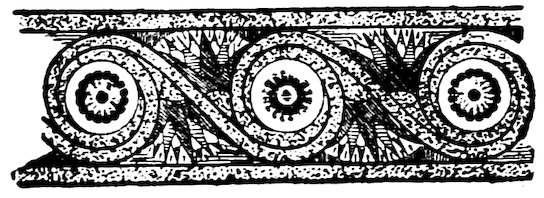
73.—P. 89.
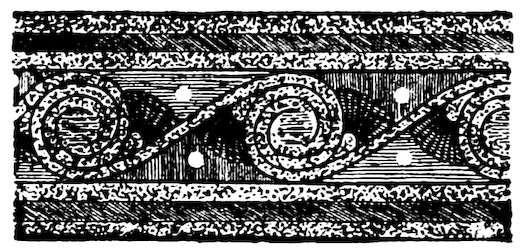
74.—P. 89.
The innumerable adaptations of this in Greek and later designs are familiar enough to us.
The influence of weaving has been very great upon these wave borders. As I 43have before noticed, the woven borders, reducing the pattern to a fret, are shown on the pre-Persian statuary at Athens, and precede the most common and oft-repeated use of the fret or key pattern borders in Greece, and thence in all classical, mediæval, and modern times.

75.—R.C. cxxi.

76.—R.C. lxi.

77.—P. 103.
Another type of border, which may be connected with this, is found in the Ramesside age. As it occurs as stitching on leather, and is well adapted to quilting or sewing bands together, it may well have been derived from that; but it is also found on metal work, with which it does not seem to be connected by origin.
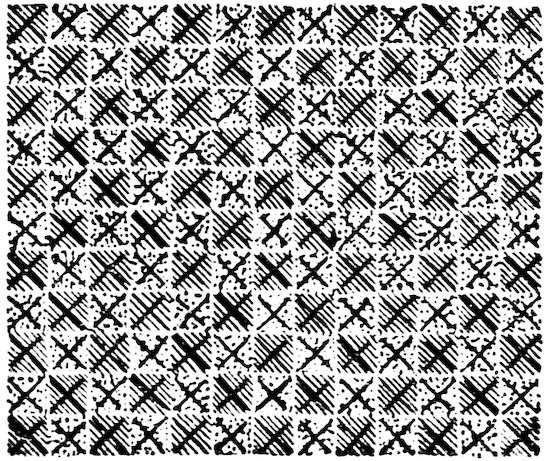
78.—P. and C. xiii.
The source of chequer patterns is unmistakably in plaiting and weaving. On the oldest monuments the basket sign, neb, is chequered in different colours; so are also the baskets of farm produce carried by the servants, as shown in the tombs. The modern Nubian basket-work is well known for the many patterns which it bears like the ancient Egyptian. The chequer pattern is found in every period in Egypt, and is perhaps most common in the latest forms on the sides of thrones in the Ptolemaic age. In the Old Kingdom many varieties were in use. The plain chequers of red or black with white, the squares filled with black and red crosses on a green and yellow chequer; or diagonal square patterns 45developed by lines of chequers, which are often not square but elongated, thus forming general and wide-spread patterns which attract the eye on large surfaces. These are best seen in the tomb of Ptah-hotep (P. and C. xiii.) and in that of Peheniuka (L.D. I. 41), both of the Vth dynasty, Sakkara.
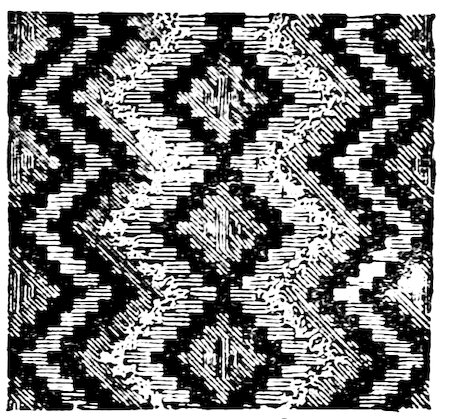
79.—P. and C. xiii.
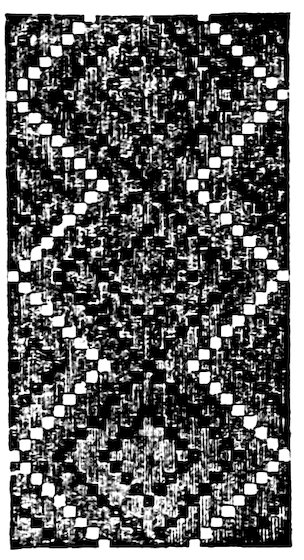
80.—L.D. I. 41.
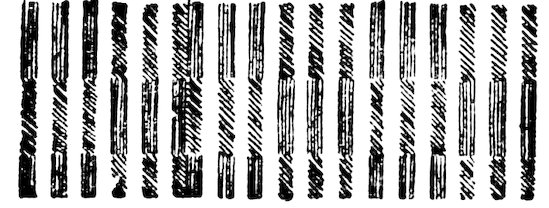
81.—L.D. II. 130.
In the Middle Kingdom we find chequers covered with bars of colour, red and green, at Benihasan.
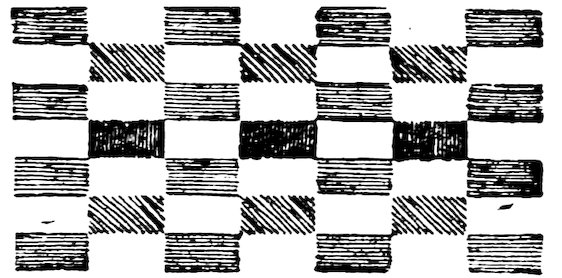
82.—P. 81.
Under the empire chequers are less common owing to the greater development of more elaborate 46decoration. A pleasing variety was formed by lengthening the squares, a change doubtless copied from weaving, where oblong squares serve to break the monotony of the pattern.
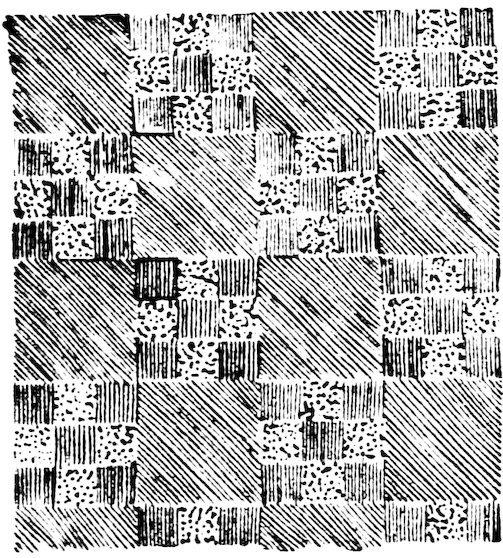
83.—L.D. iv. 77.
In later ages of the Saitic and Greek times the chequer is a common resource, but is seldom treated with originality or grace, and we do not find any new departure or advance in the mechanical execution of the later examples. One slight novelty was the alternation of whole and divided squares of colour, under Claudius.
Somewhat analogous are the net-work patterns. They seem to be probably derived from stitch-pattern over dresses. Though found in the XIIth dynasty they 47are not usual until the XVIIIth dynasty, and they are generally on the dresses of goddesses. A simple example is on a horse-cloth of Ramesside age, which shows that these can hardly represent long beads, but rather stitching or quilting. A more elaborate form is on the dress of Bast in the tomb of Seti I., in hexagons.

84.—R.S. lxxxii.
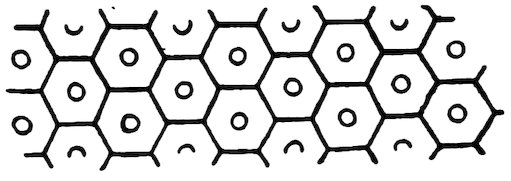
85.—C.M. ccxlii. cccx.
But this design rose to importance when it was introduced as an architectural element in the decoration of columns at Tell el Amarna. There it is coloured yellow, and the spaces are alternate red and blue.
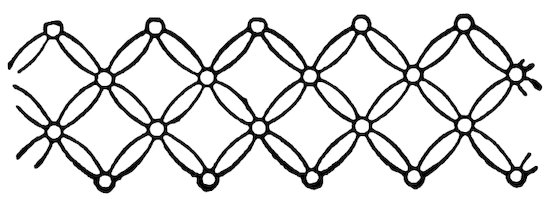
Fig. 86.
The Egyptians never used circles freely in decoration; no examples are known before the XVIIIth dynasty, and but few then.

87.—P. 79.
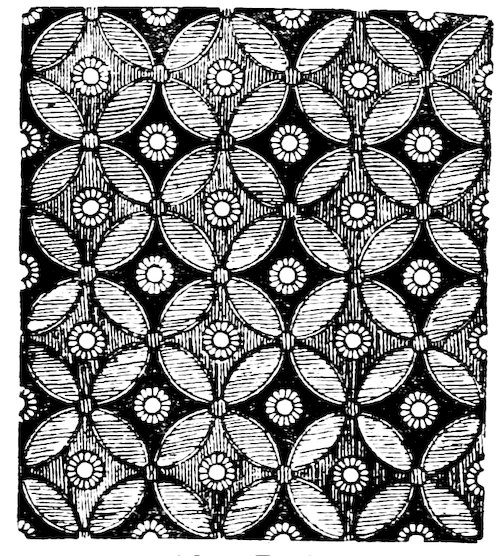
88.—P. 84.
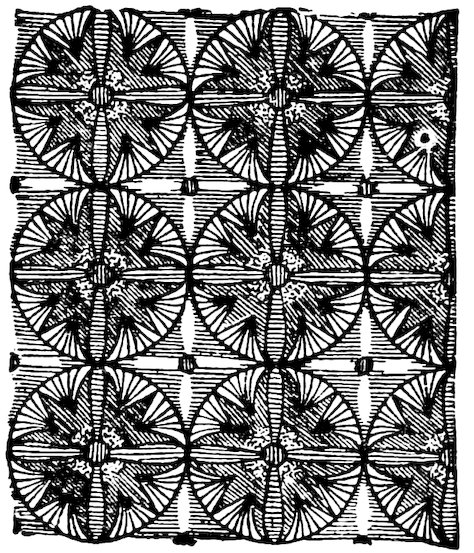
89.—P. 86.
The intersecting circles, forming a kind of net-work, are found in the XVIIIth dynasty in blue on a yellow ground; and the same occurs in black on blue and red ground, in later times (L.D. I. 41). Besides the rosettes other patterns were introduced into the spaces, which were coloured red and green alternately. But the most beautiful type was with contiguous circles not intersecting, and each containing four lotus flowers.
49The circle, however, never became of importance, probably because it was too stiff and mechanical for the Egyptian, who delighted in the waving spiral patterns and the unlimited variety of lotus developments. It is remarkable that there is not a single example of the circle divided into six, or with six segmental arms, which is so common a motive in Assyria and Syria, and which results so readily from stepping the radius around the circle. This seems to show that the Egyptian did not use compasses at any time, but always worked with a string and points. The absence of a simple and self-evident motive like the sixth of the circle is almost more striking than a peculiar motive being present.
CHAPTER III
NATURAL DECORATION
Though it might be supposed that the imitation of natural forms would be the earliest form of decoration, yet this is not the case. On the contrary, we find the geometrical forms of wave lines, and chequers copied from weaving, and the varieties of the spiral, were the first ornaments of importance in Egypt; while the natural forms of feathers and flowers were not generally imitated till a later time.
One source of simple pattern that has been little noticed is the feather, and the variety of its forms. Fortunately we have 51these different forms shown unmistakably as feathers on the coffins of the Antefs in the XIth dynasty, before we find them in common use elsewhere. Hence we can have little doubt as to their real origin. On these coffins the royal mummies are figured as swathed around in protecting wings, representing those of Isis at the sides and of the vulture of Mut on the head. The feathers have different forms according to the part of the wing which they occupy. Thus on one coffin we find all of the following types of feathers:—
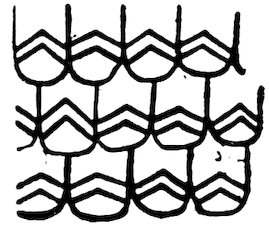
Fig. 90.
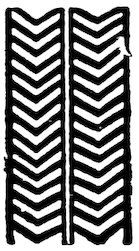
Fig. 91.
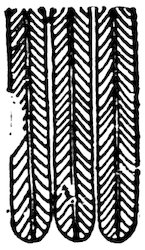
Fig. 92.
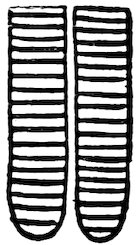
Fig. 93.
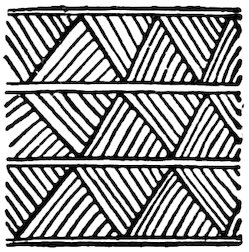
Fig. 94.
Now when we have thus been shown the conventional types which were used to represent feathers, we can identify these again in many other places, where probably 52the original idea of feather work was entirely lost; and we have a new light on some representations not yet understood.
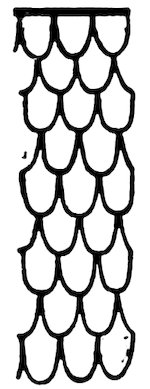
95.—Amenhotep I. R.S. xxix.
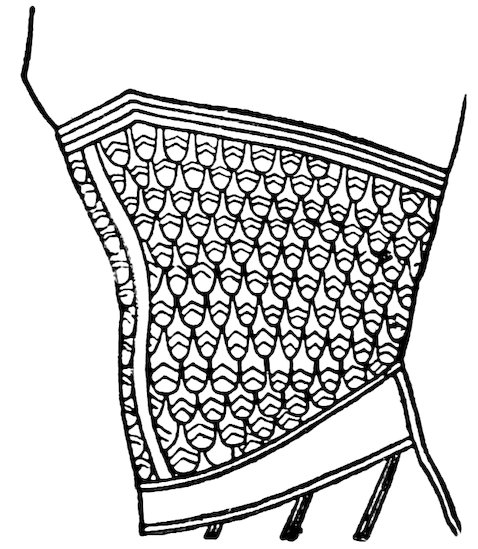
96.—Amenhotep II. R.S. xxxvii.
On the kings of the XVIIIth-XXth dynasty we often see a wide belt covering the whole stomach, which is decorated with what is commonly called scale pattern. But this occurs in scenes which are not at all warlike, and where no defensive scale armour is likely to be shown—Amenhotep I. is seated as a god receiving adoration after his death; Amenhotep II. is represented adoring Ra. And in the second case the pattern is identical with the feathers on the Antef coffin. The only conclusion is that these 53represent belts of feather work worn around the body to prevent chill, like the voluminous waist shawl of modern Orientals. Such a feather belt would be admirable for lightness and warmth, but that it is not scale armour is seen from the absence of it in fighting scenes. On the contrary, in the royal campaigning dress another form of feather work is seen in the large wings of feathers which encircle the shoulders (Ramessu II., R.S. lxxxi.).
This feather pattern is also very usual on the sides of thrones, from the XVIIIth dynasty down to the latest times. Here again it is evident that it cannot be scale armour; and a feather rug thrown across the seat, in place of the fur rug otherwise used, is a very likely thing to find in such a position.
We may, then, take this pattern, when 54used on dress or on thrones, to represent feather work. But in later times it is also used on very incongruous objects. As early as the XVIIIth dynasty the feather pattern occurs around columns as an architectural ornament (Tell el Amarna), and with the characteristic marking also about the XIXth dynasty (P. 79); also on metal work (vase, P. 97), where it must be purely an artificial marking.
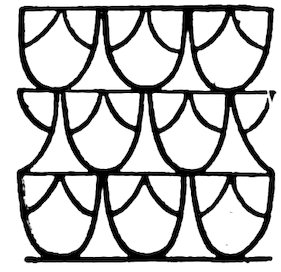
97.—P. 79.
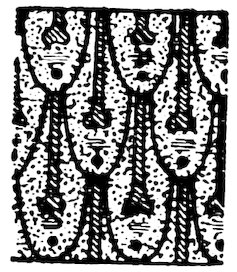
98.—P.R. lix.
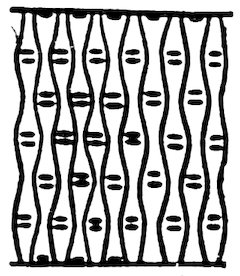
99.—R.S. lxxix.
It became elaborated under Seti I., with markings upon it, both on a dress of a god and on a throne-cover. And it became degraded into an unintelligible pattern under Ramessu II., when it appears as the dress of the god Amen.
In later times the same pattern was 55used on columns at Philæ, in an inverted and very corrupt form.
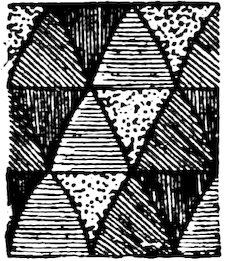
100.—L.D. I. 108.
The other forms of feather pattern shown on the Antef coffin were also found later. But they merge so readily into mere line patterns that it is not likely that they were regarded as feathers in their later use. The V pattern is found on the columns at Tell el Amarna, on belts of the kings (L.D. III. 1), on painted wooden columns (P. 73), on the harps of Ramessu III. (P. 114), and many other places.
The use of flowers for ornament is so natural that their occurrence in the earliest times is what might be expected. Yet but few flowers were adopted for decoration. The lotus is far the commonest, after that the papyrus, the daisy, 56and the convolvulus, together with the vine and palm, almost complete the material of vegetable designs. There is also, however, what may be called a generic flower ornament—the rosette—which is treated so conventionally that it can hardly receive any precise name. Sometimes in the XVIIIth dynasty it is clearly a daisy, very seldom has it the pointed petals of the lotus; and it fluctuates between the geometrical and the natural so as to defy details. One cause of this is the evident effect of leather work. The coloured leather funereal tent of Isiemkheb, found at Deir el Bahri, opens our eyes to a great deal. We there see an elaborate design, descending to long inscriptions of small hieroglyphs, all worked by cutting and stitching of leather. After this we can see in many of the Egyptian designs the influence 57of leather work; and nowhere is this plainer than in the rosettes. The earliest rosettes we know, those on the head-band of Nefert, at the very beginning of monumental history, are plain discs of colour divided into segments by white lines across them. These are discs of leather secured by radiating threads; and the same are seen in the XVIIIth dynasty, more varied by concentric circles of colours, probably successive superposed discs stitched down one over the other.
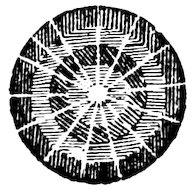
101.—P. 81.
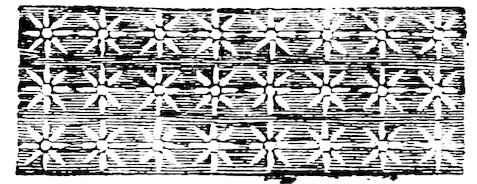
102.—P. 116.
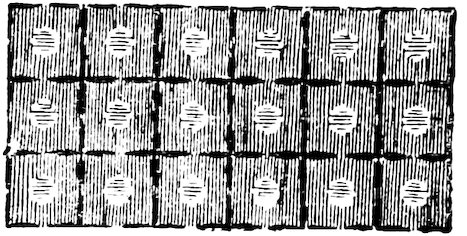
103.—P. 116.
Another stitch ornament is seen on the stuffs used for covering thrones in the XXth dynasty. There star and cross patterns are used which are evidently stitch work or embroidery; and in the spaces 58are discs of colour with white spots around, probably pieces sewn on by stitches round the edge. On a dress of Ramessu II. also are little six-pointed stars, which were doubtless stitch work.
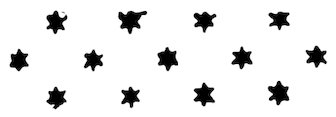
104.—R.S. lxxxiii.
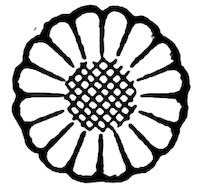
Fig. 105.
There can be no doubt of the effect that stitching has had on the use of rosettes, but other varieties are probably independent of that. The great series of rosettes is in the moulded glazed ware of Tell el Amarna; there several dozen varieties are found, varying from four petals to thirty-two. The more elaborate of these have an unmistakable daisy centre of yellow in the midst of white petals, and this indicates what was probably the flower in mind for most of them.
The rosette is found in varied use. On metal vases it is very general, and 59may either be a separate ornament of beaten work riveted on, like the rosettes on the silver ox head at Mykenae, or else embossed repoussé in the metal. Carved in wood or ivory, rosettes decorated the furniture; and they are constantly found as centre ornaments in square patterns, and along borders with the lotus or other subject.
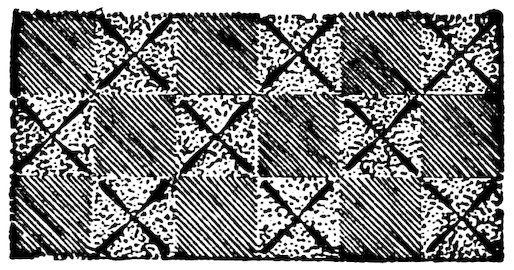
106.—L.D. II. 130.
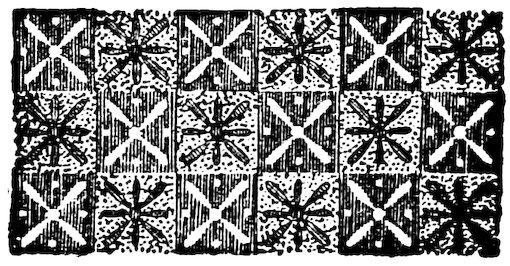
107.—P. 84.
In patterns a frequent form is only four petals, or a cruciform flower, as at Benihasan in the XIIth dynasty; and this is varied by alternations of square and diagonal arrangement.
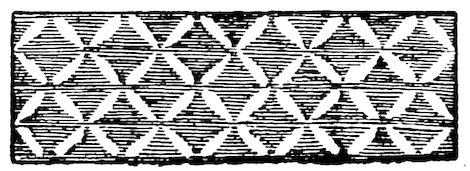
108.—P. 84.
A graceful, simple form, which again recalls leather appliquée, is yellow on a blue ground.
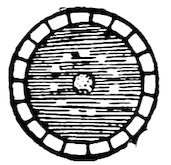
Fig. 109.
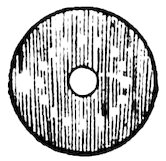
Fig. 110—P. 81.
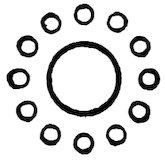
Fig. 111.
An allied pattern is the disc surrounded by spots. This is very usual on early Greek pottery, and is found on the Aegean pottery also. This is very rarely seen in pure Egyptian design, and only in the XVIIIth dynasty, when Mykenaean influence was strongest. On Neferhotep’s ceiling two forms are found, put between the horns of the bulls’ heads, like the rosette on the Mykenaean ox head. Elsewhere it is usually seen on the scarves of the negroes as a characteristic decoration, and on the dress of the Amu (C.M. cclviii.). Hence it appears to be distinctly a foreign ornament, like the other spot pattern on a zigzag line. Only three examples are published from Egyptian decoration, and those may well be due to foreign influence.
61We now reach the largest and most complex growth of Egyptian ornament in the lotus, so widely spread that some have seen in it the source of all ornament. Without going so far, we shall find plenty in it to tax our reasoning and imagination. If I prefer, in dealing with this, to ignore the developments of it seen outside of Egypt as aids to understanding it, this is only because those foreign examples are so much later that they are a reflex of various Egyptian periods, and cannot show anything certainly as to the long anterior course of development in Egypt itself.
The debated question of lotus and papyrus disappears at once when we look at the feathery head of minute flowers which the papyrus bears. That some flower, 62such as a nelumbium, was confused with the lotus seems, however, very likely. There is no doubt that in ornament different flowers were sometimes confused, and their details mixed; hence it is of no use for us to be too particular in trying to separate them. We shall therefore use the name lotus in general without necessarily entering on botanical reasons for and against it on each occasion.
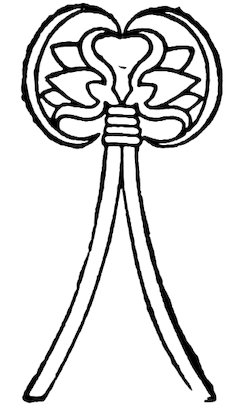
112.—L.D. II. 33; I. 27.
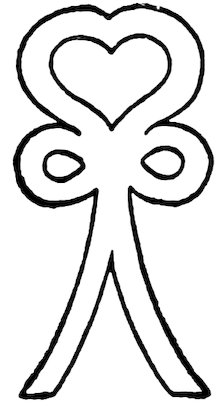
113.—L.D. III. 68. XVIIIth dyn.
The oldest use of the lotus was in groups of two flowers tied together by the stalks; such are found on the prehistoric pottery at Koptos, and on the earliest tombs. But in later times this became corrupted, and the origin apparently forgotten, by the XVIIIth dynasty.

Fig. 114.
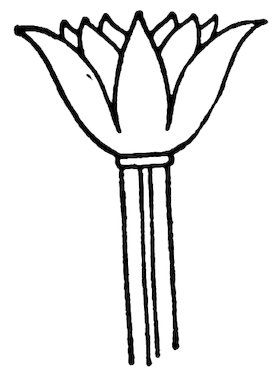
115.—L.D. II. 52. P. 74.
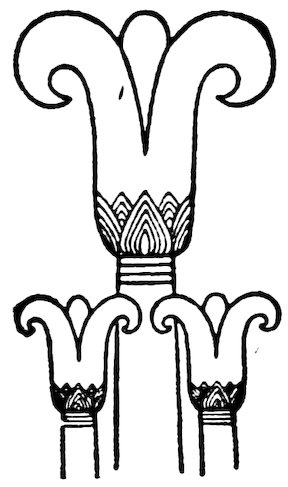
Fig. 116.
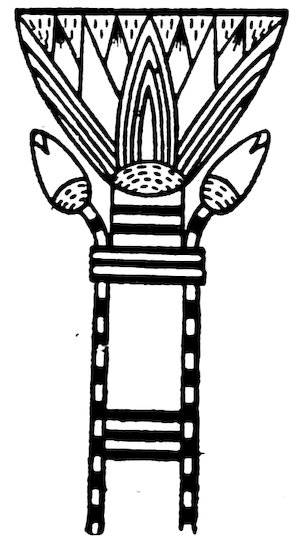
117.—P. 79.
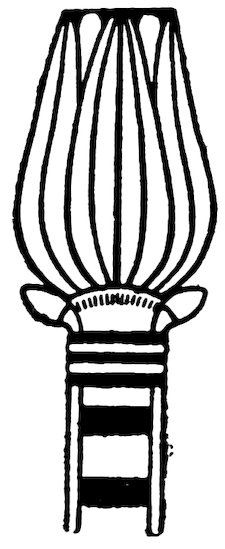
118.—P. 21. L.D. III. 76.
The plain flower was also used very early, as we see on the head-band of Nefert at the beginning of the IVth dynasty. And as architectural ornament it appears as a capital in wood of the Vth dynasty in the tomb of Imery. At Karnak there is a celebrated pair of granite pillars, one with the papyrus, the other with the lotus; and this form, with the sepals turned over at the end, became the more usual in the Empire and later times.
The variety of lotus capital is very great. The bud capital and the opened flower are 64both shown in the XVIIIth dynasty (tomb of Khaemhat); and many composite, complicated, and impossible combinations were piled together in the decadent age of the Ramessides.
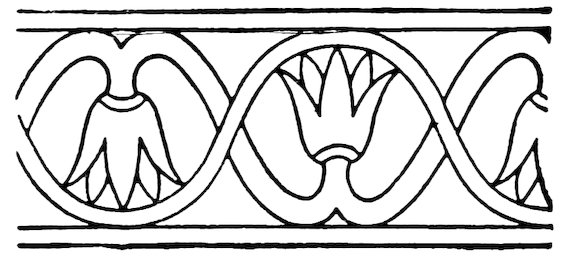
119.—P. Mon. L.

120.—R.C. lviii.
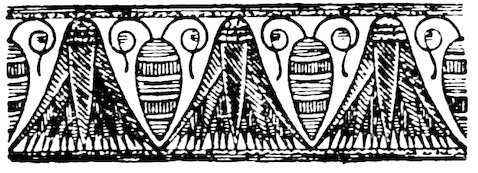
121.—P. 88.
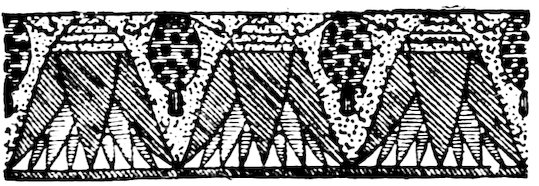
122.—R.C. lxx.
The lotus was also much used in repetition as a border pattern, but not apparently before the XVIIIth dynasty; and usually it is in alternation with buds, which fit harmoniously into the curves between the flowers. This line of flowers and buds was varied as flowers and grapes, and appears very often in the XVIIIth dynasty.
65The flower and bud was further developed in a mechanical fashion, and we can trace a continuous series of forms beginning in a flower and bud pattern and modifying the intermediate member, until on reversing the line we find that something has been evolved which is indistinguishable from the Greek palmetto alternating with the lotus. The isolated anthemion, which is so much like this, has probably a different origin, as we shall soon see.
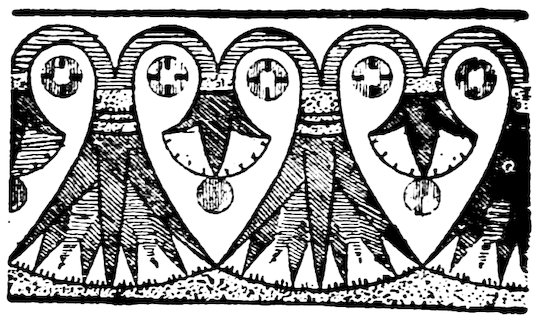
123.—P. 89. 8.
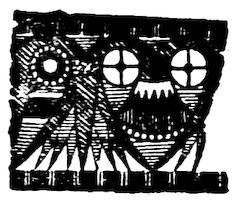
Fig. 124. 89. 9. 90. 4.
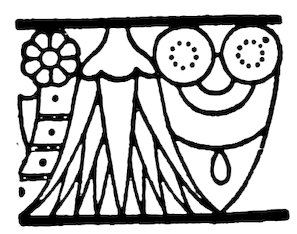
Fig. 125. 90. 5. 90. 6.
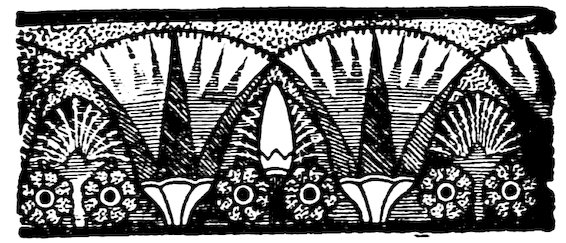
126.—P. 90. 5.
Beside using the separate flowers, the whole plant was also a favourite subject as a group. In the earliest days we find 66it entwined around the hieroglyph of union, as we shall notice in considering the hieroglyphs. In the XIIth dynasty the plant appears as a recurrent group in surface decoration; though from the varying form of the flower it might be intended for lotus or papyrus.
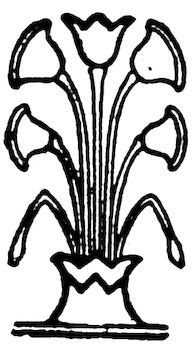
127.—R.C. xciii.
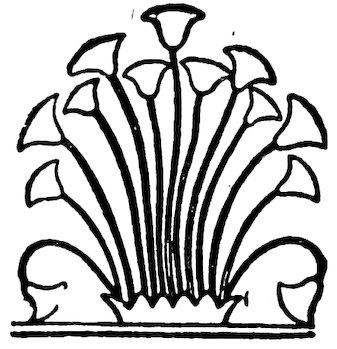
128.—L.D. III. 109.
In the XVIIIth dynasty it is more free, as might be expected in the time of Akhenaten.
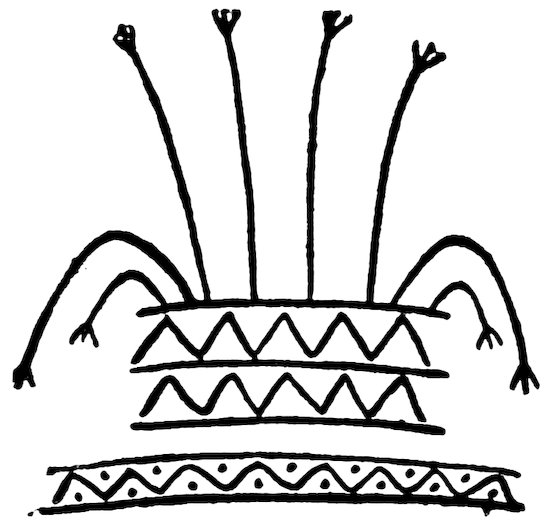
129.—R.S. lxxxiii.
It is also seen as a foreign ornament on the dress of a Syrian slain by Ramessu II. at Abu Simbel, but in this case perhaps the tufted papyrus is intended. And in place of the rounded group which is usual 67in the XVIIIth-XIXth dynasties we find a different treatment on the throne of Ramessu III., in which it is kept more as a parallel pattern. This parallelism became general in later times, and the Ptolemaic walls are ruled over with stiff friezes of lotus and bud.
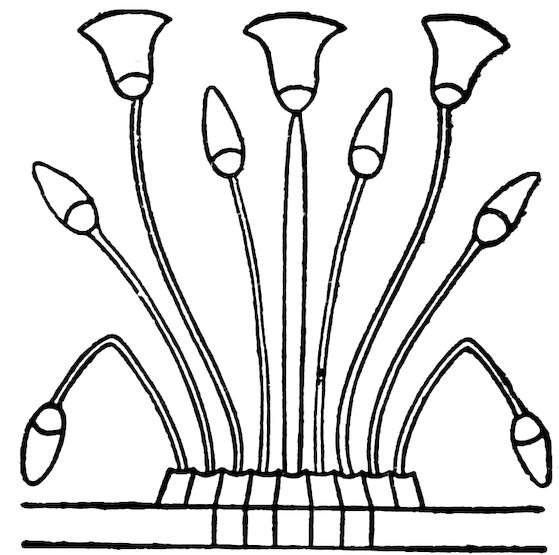
130.—P. 115.
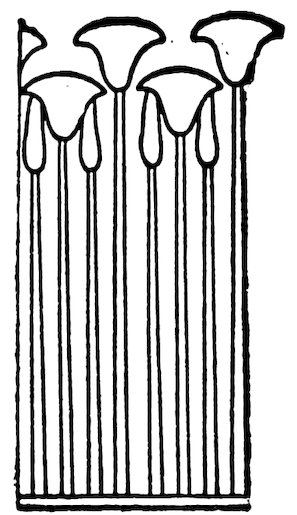
131.—L.D. II. 35.
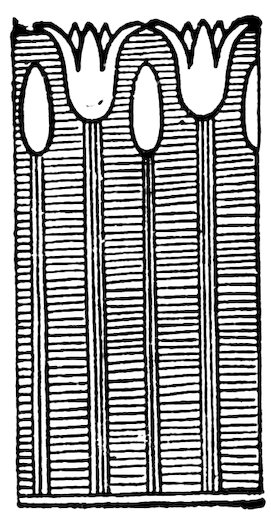
132.—L.D. II. 64.
These wall basements are preceded by groups of flower and bud in scenes, which are of the same style, as early as the IVth dynasty, on the tomb of Debuhen. Here it may be the papyrus; but in the Vth dynasty, on a basket-work screen, the lotus and bud is clearly shown. 68This pattern, however, is very seldom found as a general architectural ornament until we come down to the dull sterility of the Ptolemaic and Roman age. Then the lower part of each wall is uniformly ruled with an endless series of flowers and buds on long stems in monotonous order.
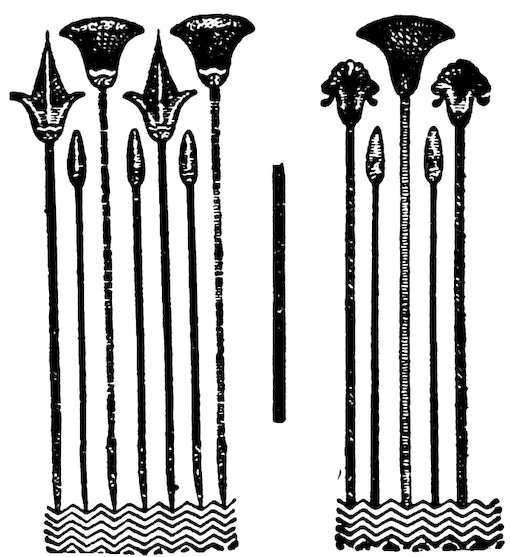
133.—P. 88. L.D. iv. 84.
We now come to the ornamental development of the flower into a monstrosity, which is only decorative and not natural, and which requires some thought and comparison to understand its origin.
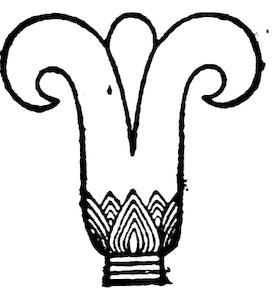
134.—P. 79.
First there is the fleur-de-lys type, with curled-over sides and a middle projection. This has not been yet explained satisfactorily; but a principle which was first 69clearly formulated by Borchardt (A.Z. xxxi. 1) will show the origin of this as well as of the succeeding forms. The Egyptian, it seems, consistently drew the interior or top view of an object above the side view. In short, they suppose things to be seen in a bird’s-eye view, and expressed that by drawing—for instance, a cup—in side view and partly in top view above that. A dish would be drawn in side view, and a top view of its compartments and contents placed over it, and the bunch of flowers that lay on it is again placed over the top view. Now on this principle we can see that the projection in the midst of the lotus flower is the third sepal at the back of the flower, the fourth, in front, being so foreshortened as to disappear altogether.
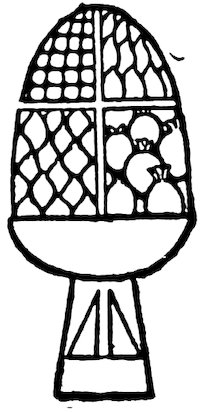
135.—T.A. I.
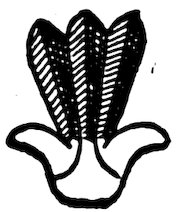
136.—T.A. 368.
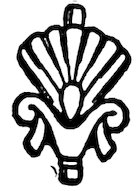
137.—T.A. 381.
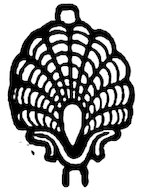
138.—T.A. 388.
This view is further complicated by showing not only some of the four outer sepals, but also some of the petals, usually three. Here the near sepal is shown rising in front, and then above these everted sepals are three of the inner petals of the flower. These might be increased to five or seven, but were generally an odd number; and they were at last evolved to a fan of petals, in which the treatment of the dish of fruit just shown is exactly reproduced, a side view of the flower being crowned by a top view of it showing the radiating petals in the interior.
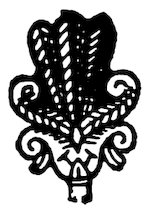
139.—T.A. 375.
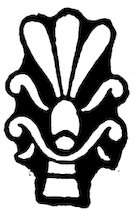
140.—T.A. 374.
So far we are on clear ground. Now we come to a more complex form, which has also not yet been explained. In the XVIIIth dynasty (from which we must mainly draw, as we have the long series of varieties in the glazed ornaments of Tell el Amarna) a strange form appears, with reversed curling arms above the calyx. Now we have seen that a third sepal is shown from the back of the flower, and the fourth is omitted which lay in front. But this was an imperfect flower, and so a diagonal point of view was taken, in which two sepals lay nearest and were seen in side view, and the two behind them were seen over them. Sometimes they are curled alike, but more generally they are curled different ways, the nearer ones downwards, the further ones upwards. Hence we get this very mechanical form, which was greatly developed in Assyrian and Greek types of the pattern. If it can be proved that the Assyrian tree pattern is earlier than this development, we could then grant what 72seems a likely influence on the development of this pattern. It was so far removed from a natural view that it soon became greatly varied and amplified, as on a bracelet in the Louvre.
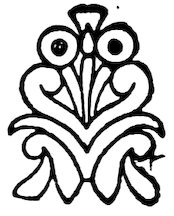
141.—P. 113.
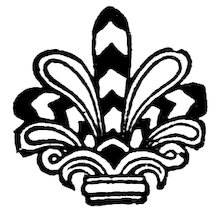
142.—P. and C. Ass. 127.
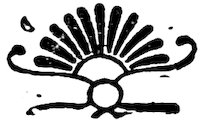
143.—Tanis II. xxxi.
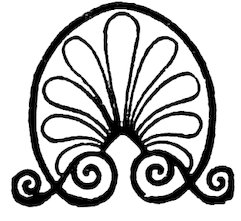
144.—Goodyear. 75.
In Assyria this became a staple design, in which the top was greatly increased at the expense of the lotus sepals below; but still the four sepals, two front and two back, are shown. In the Greek designs, however barbarous they may seem in comparison, owing to their hopeless divergence from any rational type, yet the same elements remain, and the four sepals can be traced below the view of the petals in the flower. Thus the anthemion with its double curves is fully accounted for, the lower and 73upper sepals being still distinguishable in the two spirals on each side at the base of it. The later changes of this necessarily belong to Greek art, and we cannot here follow them out.
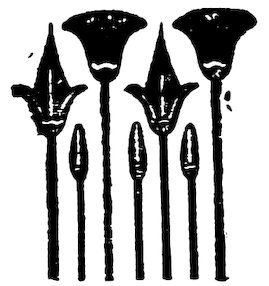
Fig. 145.
A late development of the lotus in Ptolemaic Egypt was with a central spike through the face of petals. As this spike rises from the base, it appears to be the front sepal rising before the petals.
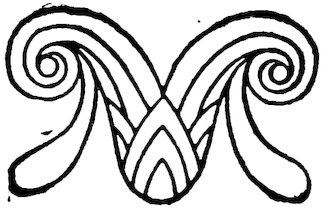
146.—P. 111.
Another variety in this pattern remains to be noticed. On very many compound lotus patterns there is a pendant from each end of the side sepals. This does not appear until the XVIIIth dynasty on the monuments: it is then sometimes single and sometimes double. But here, as in the spirals, the scarab type is an earlier stage than the architectural. 74On the architecture it is quite unintelligible, and a mere conventional monstrosity; while on a scarab of green jasper—which from the style and material seems certainly to be before the XVIIIth dynasty, and probably of the XIIth—there is an already conventionalised lotus group, with the four sepals and inner petals already developed into a sort of “tree pattern,” and the lower two sepals have a pendant, partly worn away, but clearly showing a triply-branching line like a small lotus flower. This is the earlier stage of this conventional pendant; but even here, although the pendant itself is rational, the position of it is hard to explain. Probably we must wait for some early scarab to clear up the real origin of this curious and puzzling form.
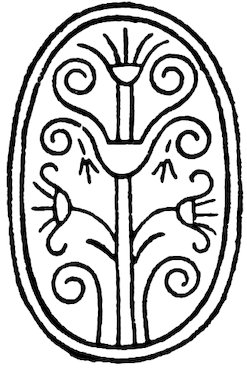
147.—F.P. coll.
75We have now traced the evolution of the various forms of the lotus pattern in Egypt, and seen how the main Assyrian and Greek types of the palmetto and the anthemion arose, which were confounded together owing to their similarity.
Other plants were often confounded with the lotus in decoration, by the ancients as well as by moderns. We have noticed some examples of this; and it is well shown in the group of boat-builders, to whom, apparently, bundles of papyrus with lotus flowers are being brought, in the IVth dynasty tomb of Shepseskau (L.D. II. 12).
Much use was made of papyrus in the floral work of Tell el Amarna. On the painted pavement groups of papyrus with large red fluffy heads of seed vessels are figured; and on the coloured tiles the landscape view of the papyrus plant in 76strictly natural treatment is a frequent subject. But these belong rather to artistic than to ornamental work.

Fig. 148.

Fig. 149.
In architecture the lotus and papyrus were largely used, in fact they form the basis of columnar decoration as distinct from that of pillars. The earliest figure of a column that is known is as far back as any dated monument we possess at the beginning of the IVth dynasty; and there it is fashioned as a stem and flower, probably carved in wood. The contracting connection with the tenon above, in a bell form, on the top of the flower, is the same as columns of the VIth dynasty (L.D. II. 111); and is the source of the much later columns of Tahutmes III. at Karnak, 77which otherwise seems to be an unaccountable “sport.”
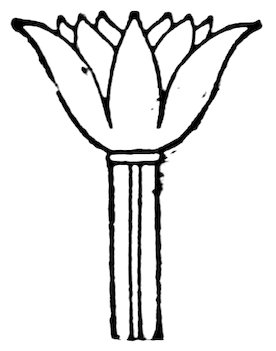
Fig. 150.
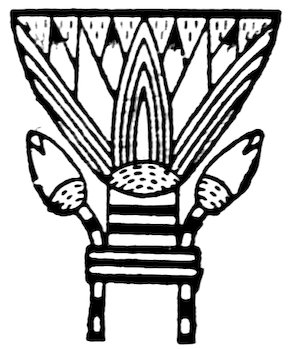
Fig. 151.
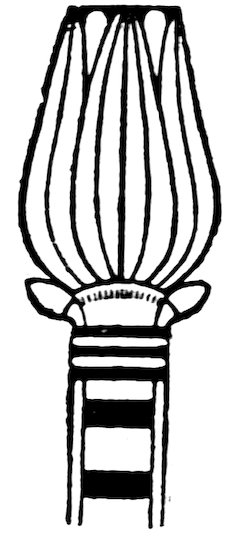
Fig. 152.
In the figures of wooden columns in the Vth and VIth dynasties, the lotus form prevails, as we have already noticed, and here repeat.
In the Vth dynasty, in the tomb of Ptahshepses at Abusir the clustered papyrus stems are a new feature; at Benihasan they are well developed; and they continued in use to the XVIIIth dynasty. But a different type then arose into predominance in the wide bell-topped lotus capitals, and with long sheath-leaves around the root; and this continued for several dynasties. But this was displaced by the elaborate composite capitals of 78Ptolemaic and Roman age, which were made up of varied elements of incongruity.
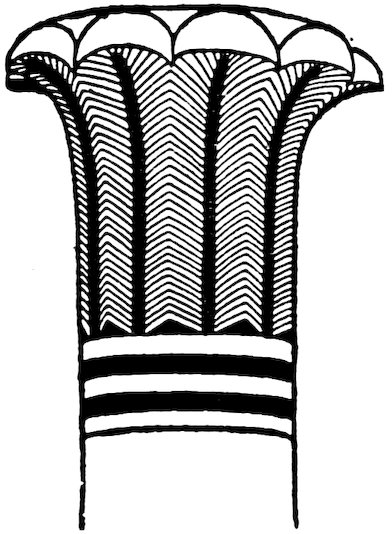
Fig. 153.
The palm, though the most important tree of the country, has had but little effect on the architecture. There is not a single example of columns copied from a palm stem; and the only instances of the imitation of the stem are in two or three instances of copies of roofing beams. The branches are not copied on columns until other subjects were well used. In the XIIth dynasty the imitation of a bundle of palm branches was made in the capitals, and it became common in the XVIIIth. Perhaps, however, as we shall see in considering the hieroglyphs, the palm column originates with a bundle of palm-sticks 79bound together. It is strange that the simple element of grouping branches round a post should not have been a very usual early motive. Was the palm really common in early Egypt? It does not enter into the hieroglyphs, and it is seldom shown on monuments till the XVIIIth dynasty; while grapes, figs, and pomegranates all seem to have been commoner than dates.
In late times not only the branches but the fruit was sculptured; and at Esneh and other Roman temples the bunches of dates are carefully rendered.
The vine is one of the oldest cultivated plants in Egypt, and all the designs copied from it are based on the idea of its climbing and trailing over the houses. It appears mainly in the florid work of the XVIIIth dynasty. The ceiling was often painted of a golden yellow, with 80vine leaves and bunches of grapes hanging from a trellis pattern which covers it. At Tell el Amarna some fragments found were very free and natural, but in the XXth dynasty it became a stiff and formal affair. (Tomb of Aimadua, Ramessu X.).
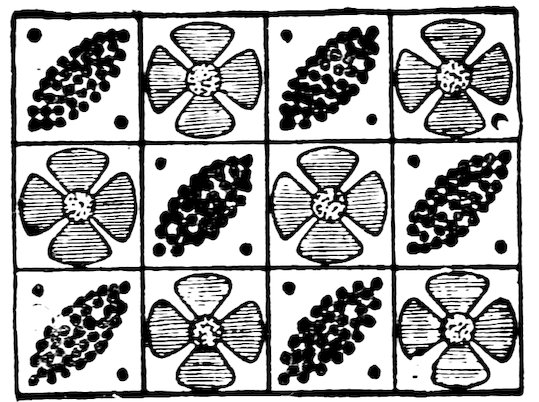
154.—P. 86.
Bunches of grapes also formed favourite pendants; as such they are painted in rows hanging from architraves of wooden buildings (tomb of Ra, Amenhotep II.); and frequently in blue glazed ware bunches of grapes are found of varying sizes, with half of the upper part cut away so as to affix them by a peg-hole to a square wooden beam of the ceiling.

155.—P. 79.
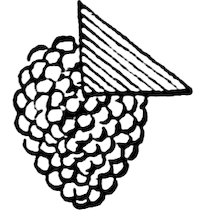
Fig. 156.
81In the Greco-Roman decoration of capitals the vine and grapes also appears, and is often very beautifully treated, as at Esneh, though essentially as a mere surface decoration, and not as an organic element.
The convolvulus has scarcely, if at all, been acknowledged as an Egyptian ornament. Yet it often occurs during the XVIIIth and XIXth dynasties. On a coffin in the Ghizeh Museum a long trail of convolvulus is beautifully modelled and painted; and during the tide of naturalism under Akhenaten the wild flowing stems were a favourite element of decoration.

157.—P. 91.
Subsequently the convolvulus is often shown as a climber on the lotus or papyrus stems in bouquets; and though its leaves then have been miscalled lotus buds, or “tabs,” yet they are clearly intended for a natural leaf of this climber, which 82is so common in the Egyptian fields.
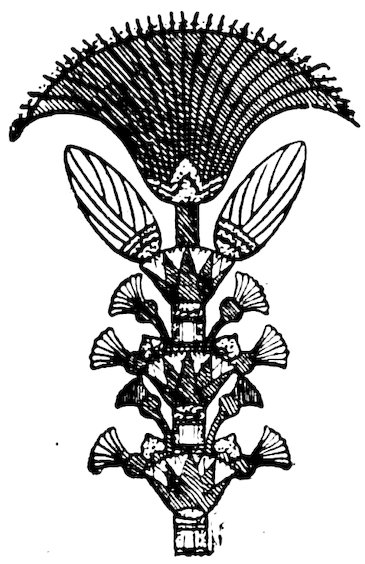
158.—P. 91.
Another field plant which played a great part in the glazed decorations was the thistle. This is naturally painted on the glazed tiles; and the glazed pendants of necklaces and wall decoration showed an abundance of thistles with green calices and purple petals. But this, like the convolvulus, was rarely used except during the beautiful period of naturalism which was most developed by Akhenaten.
Artificial combinations of flowers also became used decoratively. We have just instanced two examples from the great bouquets or staves of flowers which the Egyptians used in ceremonies.
The garlands of flower petals which are seen on the heads of women, or as collars, 83in the XVIIIth-XXth dynasties were also placed around the water-jars; and hence a painted pattern of garlands came to be used on those jars.

Fig. 159.
In architecture also the garland came into use, sometimes carved on the stone around the columns, sometimes made in coloured glaze and inlaid in the surface.
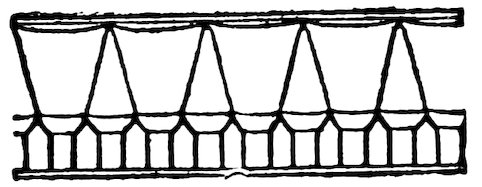
160.—T.A. ix.
Wreaths of lotus flowers and buds were also represented around the columns at Tell el Amarna.
The great pectorals, or breast-plates, of successive strings of flowers and leaves were prominent in the personal and religious decoration. The sacred barks of the gods were adorned with large and complex breast-plates, probably made of bronze, gilded and inlaid (L.D. III. 235).
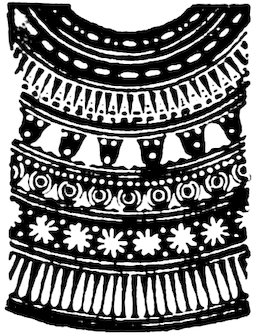
161.—P. Mon. xlix. 2.
A small example of such we have in London, with the details all inlaid in gold. These pectorals were also represented on the later vases as a complete whole.
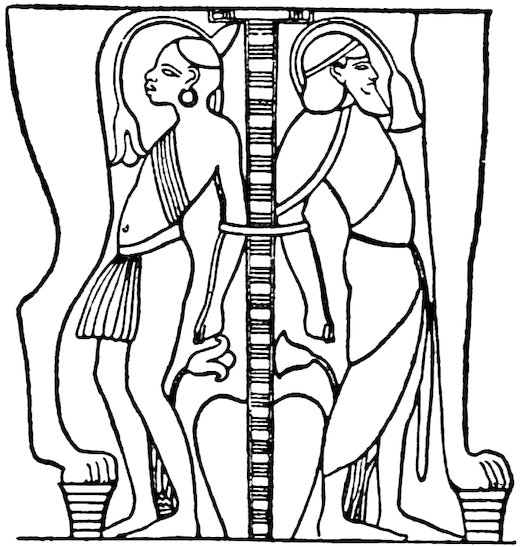
162.—L.D. III. 76.
Turning now to the men and animals shown in decoration, in the period of the Empire we constantly see figures of captives introduced to emphasise the power of the king. These first appear in the great change which overcame Egyptian art consequent upon the Asiatic conquests. Before Tahutmes III. the character and style of work continually recalls that of the XIIth dynasty; but within one or two generations a profound difference changed for ever the nature of the art, and this is reflected in the national handwriting, which shows a similar break. Amenhotep II. appears on his nurse’s knee with an emblematic group of foreigners under his feet, while he grasps cords tied to their necks; and in the same spirit he is shown, when grown up, as smiting at one blow a whole bunch of captives whom he holds in his left hand (L.D. III. 62; L.D. III. 61). Tahutmes IV. similarly is seen seated on his tutor’s knee, with his feet on a footstool ornamented with prostrate captives (L.D. III. 69). Amenhotep III. appears with figures of a negro and a Syrian bound to the sam sign on the sides of his throne, and henceforward the abasement of captives was an essential idea to Egyptians. But it should be remembered that common as the notion was in 86late times, it is originally Asiatic and not Egyptian; the king trampling on the nations and making foes a footstool are ideas not found in Egypt until the Semitic conquests of Tahutmes III., though the earliest figure of a sphinx trampling on a captive is under the XIIth dynasty.
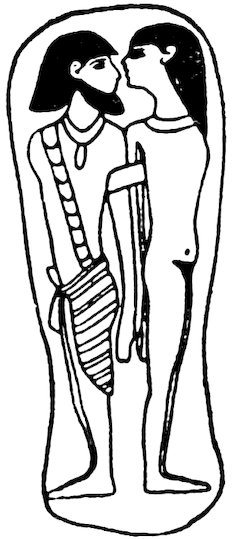
Fig. 163.
Under Akhenaten six various races are represented on the sides of his great balcony (L.D. III. 109), and the alternate negroes and Syrians are painted on the passage floors of his palace, or carved in blocks of alabaster to be trodden under foot. Down the various ages this symbolism recurs in decoration until in Ptolemaic and Roman times every decent Egyptian had captives painted on the soles of his sandals in which he was buried, so that for all eternity he might tread down the Gentiles.
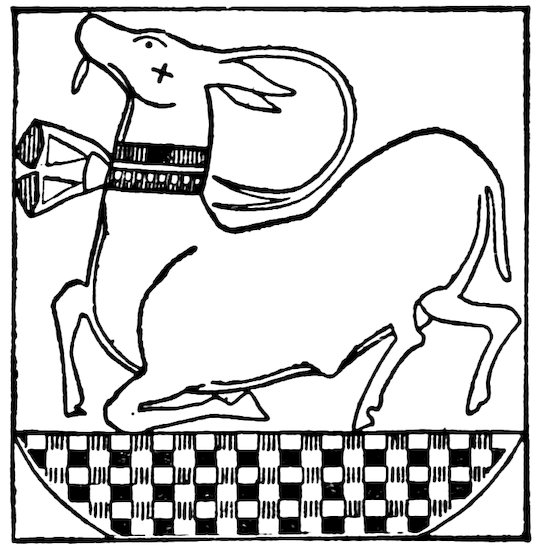
Fig. 164.
Among animals a favourite in decoration was the ibex, but it was not introduced till the XVIIIth dynasty. It often appears on the finger-rings of Akhenaten’s time, and later upon the funeral tent of Isiemkheb, ingeniously adapted to fill a square space.
The bull or young calf was more frequently introduced; on the wooden boxes and trays it is shown as bounding in the meadows, and it is continually used in the groups of the painted pavement at Tell el Amarna.
Birds are also a common subject for decoration, though only dating from the same period as the other animals. Besides the symbolic or sacred use of the hawk and vulture, the very secular duck was a 88favourite bird. On the great pavements of Akhenaten it appears above every group of plants.
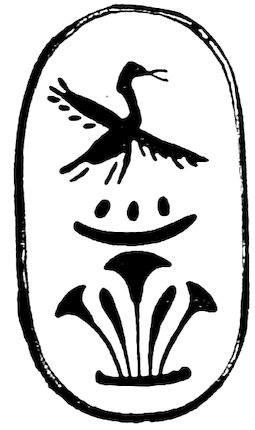
Fig. 165.
On rings it is often engraved fluttering above its nest; and in the decadence of Egyptian art in the XXth dynasty the incongruous idea was adopted of birds, eggs, and nests all upon a ceiling.
The natural ceiling pattern adopted from the early days of Egyptian art was of golden stars on a deep blue ground; not a dark daylight blue, as in modern imitations, but a black night blue. These are always five-pointed stars, with a circular spot, usually of red, in the centre.
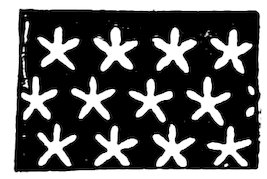
Fig. 166.
It is noticeable that the Egyptian views 89a star as surrounded by long streamers of light; because to a long-sighted person, or any one with proper spectacles, the stars appear as points of light without radiations. Hence it seems as if the Egyptians were short-sighted people from the early ages.
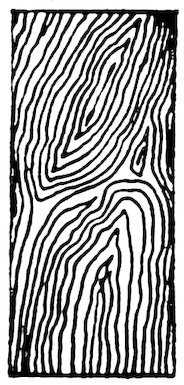
Fig. 167.—L.D. II. 19.
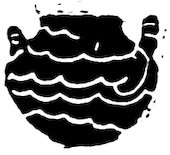
Fig. 168.
Lastly we may notice the base imitation of nature in copying the grain of wood, which we find done in the earliest times of the IVth dynasty, and continued down to the period of the Empire. Stones were also imitated by painting, and red granite is frequently copied in the earlier days, on the recessed doorways of tombs. In later times vases of valuable stone were imitated by painting over a pottery vase, and such cheap substitutes were commonly placed in the tombs.
These base imitations are of æsthetic 90interest as showing in what a different manner the Egyptian viewed his materials from that of our standpoint. He stuccoed and painted over his hard stone statues; it was enough for him to know that the stone was hard and imperishable—he did not need to see it always exposed. The imitation of nature was the standpoint from which he started, and he had no objection to carry out that imitation with paint or otherwise; our abstract standpoint of an artistic effect which must never involve falsity, but which may have little or nothing to do with nature, was altogether outside of his æsthetic.
CHAPTER IV
STRUCTURAL DECORATION
In the persistence of certain forms which were the direct result of the structure of a building or object, we have a very considerable source of decoration. In Greek architecture many of the details are entirely the product of wooden construction translated into stone. The triglyphs, the imitation of nail heads, of the ends of the poles supporting the roofing, of the crossing of beams at the coffers, are all details which are retained as decoration long after they ceased to have any structural meaning, owing to an entire change of material. Such is 92structural decoration in its best known forms. But the same principles equally apply to Egyptian architecture; there the original material was not sawn wood as in Greece, but rather the papyrus and palm branch, with the ever-present mud plastering and mud bricks. The decorative details of the stone architecture have come down from this stage of building, translated point for point into stone, just as the Greek translated his wooden architecture into marble.
But pottery preceded stone in Egypt, and one of the simplest of ornaments arose from structural necessity. To this day may be seen in the Egyptian pottery yards bowls and jars held together by a twist of rough palm fibre cord, while they dry in the sun before baking. This accidental marking by the rope in the wet clay is seen on the pottery of all ages; but it became developed as a pattern apparently 93in the twist or guilloche, which may perhaps be rather derived from this than from the chain of coils or wave pattern.

169.—H.S. 383.

170.—Kahun Pot.
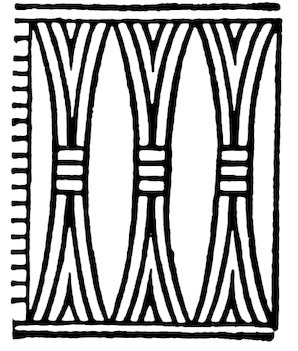
171.—L.D. II. 63.
Basket-work was elaborately developed in the Old Kingdom. There were beautiful screens represented behind the figures of the owners of the early tombs; they might in some cases be matting instead of basket-work, but others of the patterns appear certainly to be of a rigid material. In no case are they likely to be “mats on which the kings stand,” as styled by Owen Jones. Among the various patterns of platting which are readily developed, squares, waves, zig-zags, chequers, &c., there are some 94made by binding the fibres into bundles, and so making a kind of open work, which may well have led to the pattern of connected rhombs which is so usual on Oriental pottery.
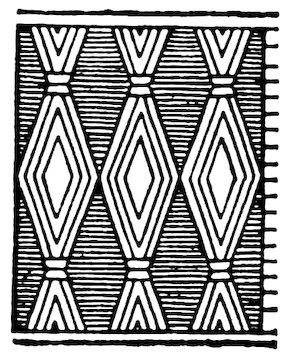
172.—L.D. II. 63.
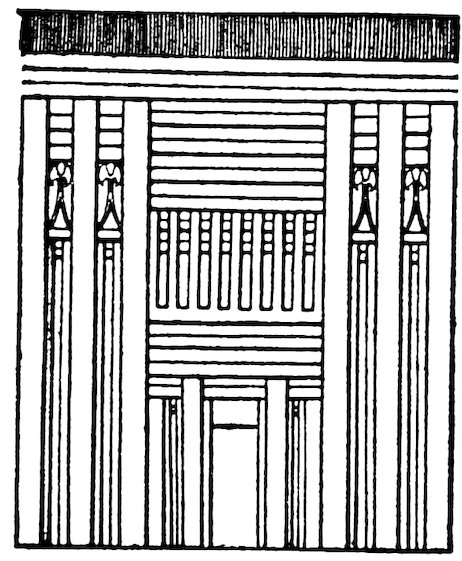
173.—L.D. II. 17.
One of the most familiar early motives is wooden framing. This is continually imitated in the stone figures of doorways in the tombs. The details of it show that a frame or grate of joinery must have been used for the porch of large houses, so as to admit light and air while the door was fastened. The prevalence of such wooden frames or lattices in modern times in Egypt—known as mushrabiyeh work—shows how suited such a system is to the climate. Long 95after the use of stone was general the frames were imitated, and the pattern survived as a decoration. The same style of framing was used in the upper part of a house, with decorative uprights of the hieroglyph tat, and was copied as a fancy decoration in furniture, as seen in a beautiful ivory carving in the Louvre. This style survived until the XVIIIth dynasty, when it is seen in a tomb at Thebes (Amenhetop II., Prisse Art) and at the temple of Sedeinga under Amenhotep III.
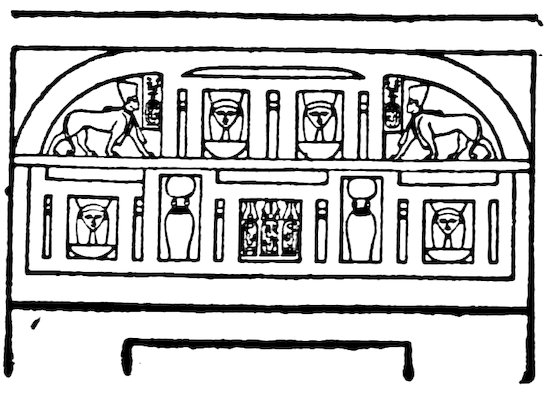
Fig. 175.
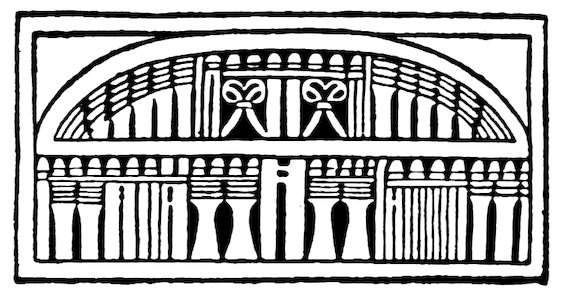
Fig. 174.—Ghizeh.
Much akin to this wood framing is the panelling of the brickwork which is seen in the earliest examples 96in Egypt, and is identical with the panelling of walls in early Babylonia, one of the indications of a common civilisation of the two great valleys. This panelling does not seem to have lasted beyond the Old Kingdom; there was no trace of it found at Kahun or Gurob, in the buildings of the XIIth and XVIIIth dynasties, nor does it appear in any drawings or imitations of buildings.
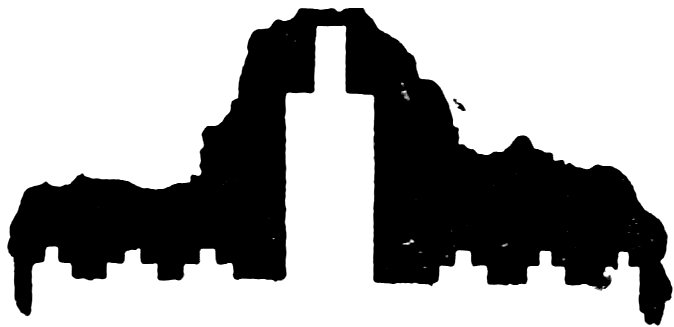
176.—P. M. vii. (plan).
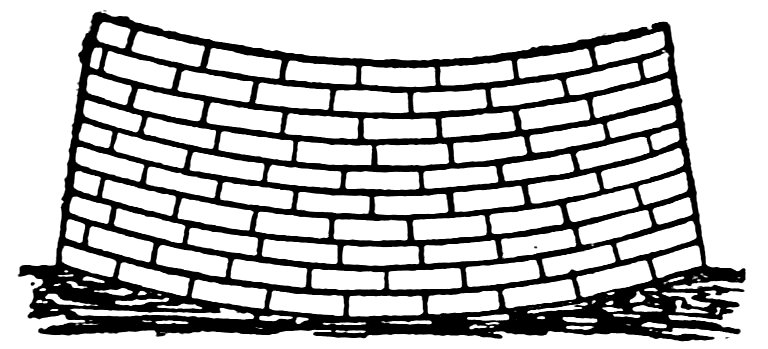
Fig. 177.
One of the best known characteristics of Egyptian architecture is the sloping face of the walls and pylons. This is directly copied from brickwork. In order to give more cohesion to a wall it was the custom to build it on a curved bed, so that the courses all sloped up outwards at the outer corners. Thus the outer faces sloped 97inwards, and the wall had more stability. So wedded were the builders to this method, that where a long wall of a fort or city was to be built they preferred to begin with a row of towers of brickwork thus arranged, and then to fill in the spaces between them with more plain walling. This slope of the walls was copied in stone at the earliest time. The temple of Sneferu at Medum has a slope on the face of about 1 in 16, and it was continued down to the very latest age of Roman building.
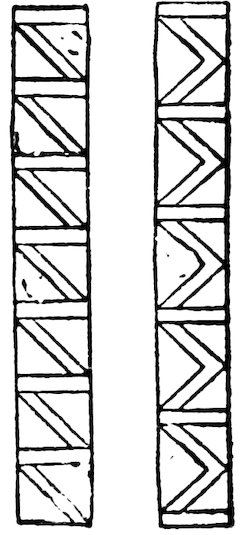
178.—Perring. L.D. II. 44.
Another familiar feature is the roll or torus down the corners of the buildings. It is usually ornamented by a pattern of binding. This—as was well pointed out by Professor Conway—is evidently a bundle of reeds bound together, and put down the angle of the 98plastering in order to preserve it from breaking away. Such a construction was an ugly necessity at first, but when stoneworking arose it had become so familiar that it was faithfully copied in stone as a decoration, and continued to be so copied for more than four thousand years, as long as Egyptian architecture lasted.
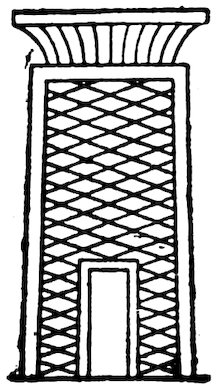
Fig. 180.
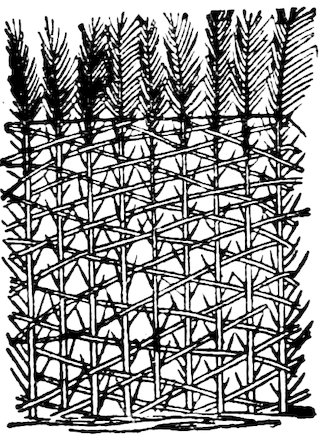
Fig. 179.
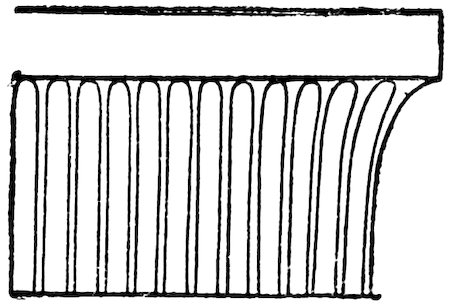
181.—L.D. II. 112.
The well-known Egyptian cornice has been so long taken for granted that it might seem never to have required an origin. Yet in the villages of the Fellahin to-day palm cornices may be seen in course of development. A fence is formed of palm-sticks, placed upright, and stripped of leaves for some way up. The tops are left bushy, and serve to prevent men or animals climbing over the courtyard wall. The upright sticks are tied together by a rope near the top, or lashed on to a cross line of sticks. The fence is stiffened below by interweaving other palm-sticks in both directions; and then the whole is plastered with mud up to the tie level. Here we have the cavetto cornice being formed by the nodding tops of the branches; and to clinch the matter, the earliest representations of that cornice are on figures of buildings which show the crossed sticks of the fence below the cornice. The ribbing of the cornice is seen on the earliest examples, on Menkaura’s sarcophagus in the IVth dynasty (Perring), in the Vth dynasty (L.D. II. 44) and the VIth (L.D. II. 112), and 100such was copied until late times. But in the more decorative cornices of the XVIIIth dynasty the ribbing was broken up by cross lines, sometimes curved upward, sometimes downward. These cross lines must be a degradation of the leaves of the palm branch. In later times they are omitted, and the pattern becomes simply striped.
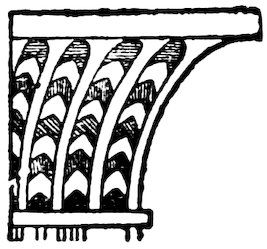
182.—L.D. III. 115.
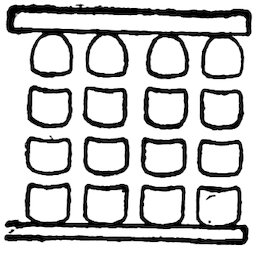
Fig. 183.
This cornice was copied in Syrian architecture, in the plain form without ribbing, as in the tomb at Siloam and the slabs of Lachish; but it does not appear to have ever taken root in Assyria, though attempted there, nor is it known in Europe.
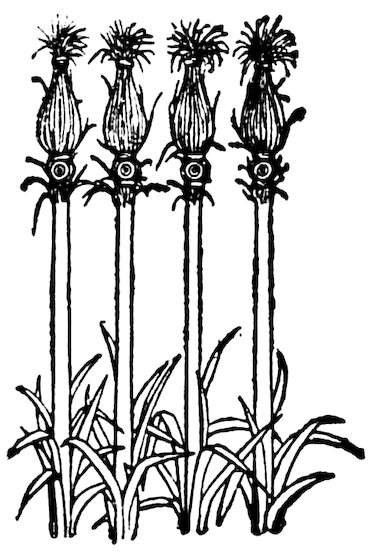
Fig. 184.
The other main type of Egyptian cornice is what is known as the Khaker, from the equivalent of the sign as a hieroglyph in inscriptions. This only means “to cover” or “to ornament,” and therefore refers to the position of the decoration and not to its origin. The clue to the real nature of this decoration is given in a tomb of the IVth dynasty (Ptah-hotep, L.D. II. 101. b.), where we see the khaker ornament not as a mere painting, but represented as standing up solid around the tops of the cabins of boats. It cannot therefore be anything very heavy or solid, such as spear-heads, as has been proposed. It probably results in some way from the construction of the cabins. They must have had roofs of very light material. Papyrus was generally used for building boats, and therefore for cabins also, most likely. This gives us the clue to interpret it. Suppose a screen of papyrus stems; the roofing stems tied 102on to the uprights; and the loose wiry leaves at the head tied together, to keep them from straggling over and looking untidy. Here we have all the details of the khaker ornament simply resulting from structural necessity. The leaves are gathered together at the lower tying; there the end view of the concentric coats of the papyrus stems of the roof are seen as concentric circles; above which the leaves bulge out and are tied together near the top. Though this structural decoration is seen on the top of boat cabins as early as the IVth dynasty, yet we have not found it as decoration on a flat surface until the XIIth. Then it is very common; but its meaning became confused in the XVIIIth dynasty, and in Ptolemaic times it is seen in absurd positions, as on a base, and on architraves above an empty space, where no stems below it were possible.

185.—Prisse 88.
103We have just mentioned one use of reeds or papyrus in the torus roll on the edge of buildings; but on interior decoration we meet again with the same motive. The borders of Egyptian scenes from the earliest times are framed with a variety of bindings; and so suitable did such bordering seem that it was continued with but little variation throughout all the history. The oldest forms are—

186.—L.D. II. 43.
plain binding,

187.—L.D. II. 44.
a diagonal binding,

188.—L.D. II. 44.
or

189.—L.D. II. 54.
and crossed binding.

190.—L.D. II. 148.

191.—L.D. II. 132.
The latter became modified into— by the XIth dynasty, showing that its meaning was already becoming forgotten. But a modification of the tower ends of this pattern in the XIIth dynasty is difficult to understand; unless we can look on it as an irregular winding of the ends of the cord around the reed bundle in place of the regular crossing which is shown above it.

192.—L.D. II. 115.
The modification of colours and arrangement in the plain binding is interminable. In the XVIIIth dynasty we find

193.—L.D. II. 136.
in the XIXth

194.—P. 72. 76.
in late times

Fig. 195.
and in all ages a binding with a number of lines between coloured spaces was common

Fig. 196.
and on borders of architecture and statuary thrones
CHAPTER V
SYMBOLICAL DECORATION
The Egyptian who expressed all his thoughts by a symbolical writing, full of determinatives, was naturally much given to symbolism in his decoration. Not, however, that all his decoration was symbolic in a recondite sense; the ever-present lotus ornament was merely a thing of beauty; the lotus was not a sacred plant, it is not associated with any divinity in particular, and only in one unusual instance does it ever occur in the hieroglyphs. The fanciful habit of Europe, in seeing a hidden sense in every flower, was 107not akin to the simple and elementary mind of the Egyptian. But certain striking emblems he used continually; and one of the earliest of these is the uraeus snake, or cobra in his wrath, reared up with expanded body ready to strike. The dignity and power of the animal made it to be an emblem of the king, or rather perhaps of the royal power of death. That capital punishment was used in Egypt is seen in the Westcar Tales, which probably date from the Old Kingdom, where a condemned malefactor is ordered to be brought forth for a magician to try his power in bringing him to life when slain. The king, as having the power of death, bore the uraeus always on his head-dress; and from the earliest days (at Medum) the royal court of justice was adorned with a cornice of uraei, implying that there resided the royal right of judgment and of condemnation. 108This cornice seems, however, to have been regarded as merely royal in later times, and was freely used to adorn any royal structure, even a wooden summer-house (Amenhotep II.); or the uraei formed a band around columns (Akhenaten), or appear as supporters of the royal cartouche (P. 72), either plain (Ramessu II.) or winged (Horemheb L.D. III. 122).
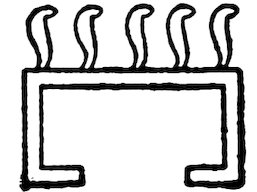
Fig. 197.
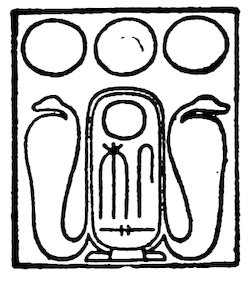
198.—P. 72.

Fig. 199.

200.—Khufu.

201.—Unas.
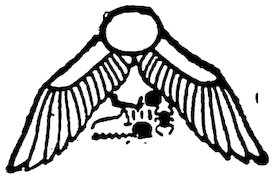
202.—L.D. III. 122a.
A symbolism closely connected with this is that of the globe and wings. This certainly dates to the beginning of the monumental age, as it is seen above the figure of Khufu seated on an amulet. In that instance it is on too small a scale to show the details; but in the next dynasty it appears above Unas at Elephantine, with the globe flanked by two uraei and two wings. What the symbolism of it was we have no direct information. But when we consider that the wings are those of the vulture spread out, as it appears on the roofs of the passages as a protecting and preserving maternal emblem, and the uraeus is associated with it, we can hardly view it as other than the same idea of the power of life and death, of preservation and destruction. But in this emblem it is not the king who wields these powers, but Ra the Sun, whose disc appears in the midst. That the wings have thus the meaning of protection is shown by the globe with drooping wings embracing the royal name, expressing the protection given by Ra to the king, without associating the deadly or 110punitive power of the uraeus. A curious form of this emblem which was common in the early part of the XVIIIth dynasty is with only one wing.
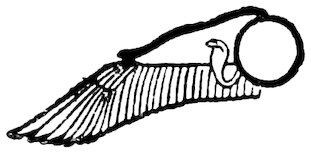
203.—L.D. III. 8.

204.—P. 72.
One of the most perfect and beautiful examples of the winged disc is on the temple of Tahutmes III., but it continued to be used down to the latest times of Egyptian architecture as a lintel decoration.
In the XIXth dynasty an addition to the symbolism appears; the horns of a ram are added to the wings; sometimes without the uraei (Ramessu I., L.D. III. 131), sometimes with the uraei (Ramessu II., L.D. III. 204). These rams’ horns can hardly be other than those of the ram-headed god Khnum, “the maker” or “modeller” of men. The idea then of 111the wings and horns is that Ra makes as well as protects; and where the uraeus is added it implies that Ra is creator, preserver, and destroyer.
The vulture alone as the emblem of protection is frequently figured with outstretched wings across the ceilings of the passages, particularly those of the royal tombs of the XIXth dynasty. There is perhaps no sight in the animal world more imposing than one of these birds, stretched out with a span of some nine or ten feet, hanging in the air close overhead; it is natural that it should have excited the admiration of man, and not being hurtful it readily came to be honoured as a type of maternal care.
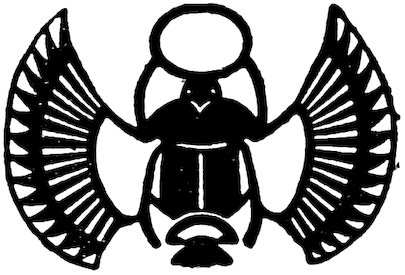
205.—P. 81.
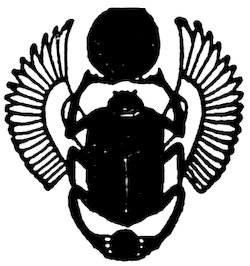
206.—L.D. III. 235.
The scarab was another such typical animal, rolling the pellet containing an egg to a safe place where it buries it. Though very common as an amulet for the living and the dead, yet it is not often seen in symbolical or decorative use otherwise. With what idea the amulet was used we do not know for certain. The scarab itself is often figured as holding the disc of the sun between its claws: and it is at least possible that the symbolic idea of the scarab as the maker or creator arose from the burial of its ball being an emblem of the setting of the sun, from which new life will arise in due course. It occurs with the wings extended and the disc between the claws as a centre figure in the space of a ceiling pattern (Neferhotep, XVIIIth dynasty), and on the border of the covering of a shrine under Ramessu X., and 113is occasionally met with later in decoration.
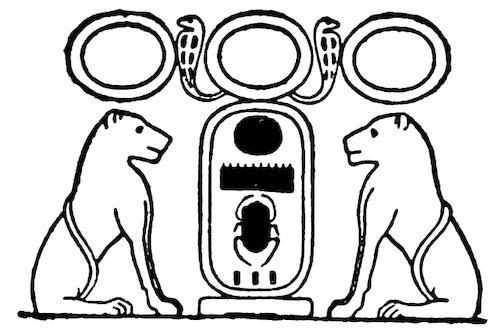
207.—R.C. cxxx.
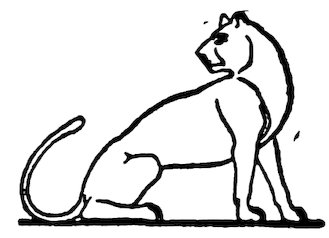
208.—P. 78.
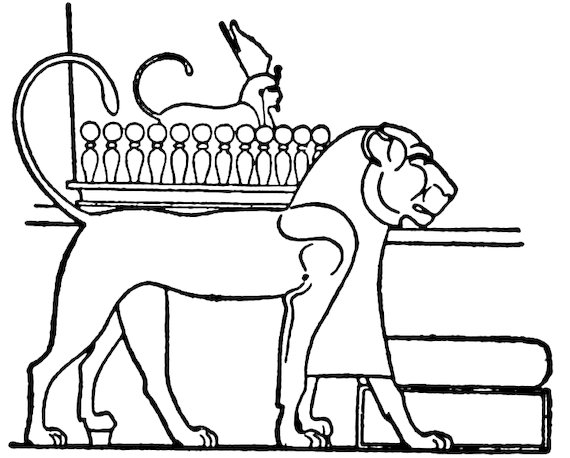
209.—L.D. III. 100.
The lion as a noble and royal animal frequently figures in the XVIIIth dynasty. The Egyptians, with their marvellous instinct for taming every animal they could find, actually trained lions or leopards to live as domesticated animals, with the same sort of allowed wildness as modern hunting dogs. The lion accompanied the king in battle; but in camp it lay down as peaceably as an ox. It was frequently carved on the sides of the thrones of the XVIIIth-XXth dynasties, and also seated in pairs, facing or backing, on the 114temple walls, a usage reminding us of the lion gate of Mykenae of the same age.
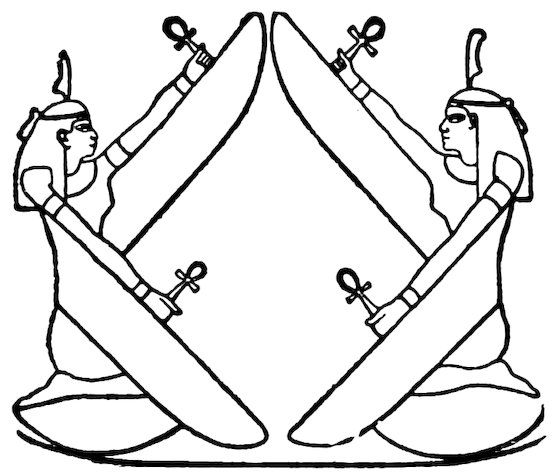
210.—L.D. III. 114
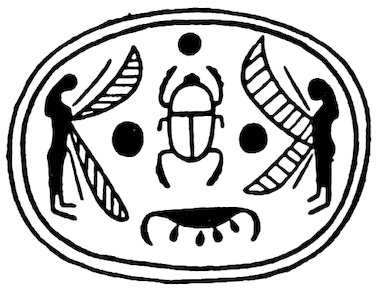
Fig. 211.
Some of the Egyptian divinities also appear as symbolic ornaments. The figures of the goddess Maat with spread wings adorned the ark of Amen-ra under Tahutimes II.; and in earlier times similar cherubic figures stand guarding the name of Antef V. on a scarab.
Hathor also appears on various objects. A mirror handle carved in wood during the XIIth dynasty has the head of Hathor (P. 1. xiii.); columns with heads of Hathor, crowned with a shrine occupied 115by a uraeus, are found introduced by Amenhotep III. in his temples at El Kab and Sedeinga, and were copied by Ramessu II. at Abu Simbel. The similar head of Hathor was frequently made in glazed pottery as a pendant in the time of Akhenaten. And in later times these Hathor headed capitals became usual under the Ptolemies, as in the well-known case of the portico of the great temple at Dendera.
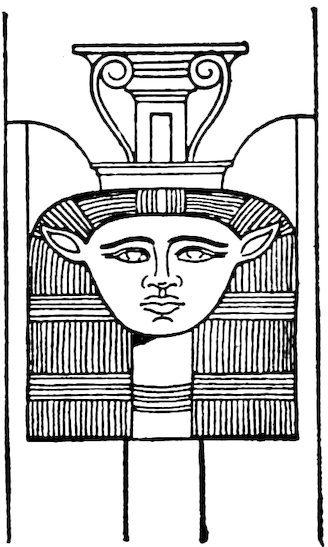
212.—L.D. I. 100.
Bes was one of the favourite popular deities of the Egyptians; restricted to no place in particular, every votary of music and the dance patronised Bes. The little statuette of a dancing girl with a Bes mask on, besides an actual mask in cartonnage, found at Kahun, show the popularity of the god in the XIIth dynasty. 116In later times his figure is frequently seen. At Tell el Amarna ornaments for necklaces made in glazed pottery followed two types of Bes, the god dancing with the tambourine seen in side view, and the earlier grotesque front view, with arms akimbo. These familiar little figures continued to be made till late times; and in the Roman age Bes was elevated to architectural dignity on the dies above the columns at Dendereh in the small temple of the Mammeisi.
Another and more artificial mode of symbolical decoration was by means of the hieroglyphic signs. Having a mode of writing in which a single mark could express an abstract idea, it was possible to adapt writing to a purely decorative 117design. Even with alphabetic characters this has been done, as in the elaborate crossing patterns of the earlier Arab period in Egypt, in which no untrained eye would see anything but a complex ornament.
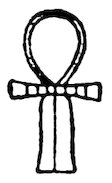
213.—Ankh.
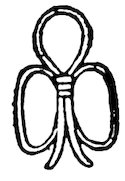
214.—Thet.

215.—Uas.

216.—Dad.
Four of the hieroglyphs most usually worked into ornamental designs are the ankh, a girdle, or symbol of life; the thet, another form of girdle, with longer bow-tie in front, which, as always identified with Isis, may have been a primitive feminine girdle, the ankh being masculine; the uas, a stick of authority, or symbol of power; and the dad, a row of columns, or symbol of stability.
As early as the Old Kingdom we find wooden framings, or lattices, ornamented with dad signs; and 118this continued at least as late as Amenhotep II. The dad also appears in what is probably copied from pierced woodwork, in a relief at Qurneh of Ramessu I.
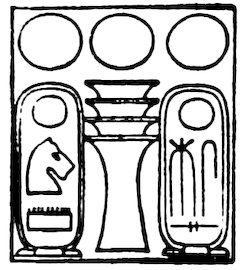
217.—L.D. III. 131.

Fig. 218.
The combination of thet dad uas, and of ankh dad uas, is found in the XIIth dynasty at Benihasan, apparently carved in relief, on the wooden panels of a litter (R.C. xciii.). The same occur similarly carved on the ebony doors of Hatshepsut at Deir el Bahri. The group begins to appear as an architectural design early in the XVIIIth dynasty, and continues down to Roman times, especially on bases of scenes and groups, thus forming a continuous border of good wishes. The hieroglyphs, ankh, dad, and uas, are all found on pendants for necklaces, in the blue glazed pottery of 119the XVIIIth dynasty, and also combined in one as a ring bezil. And the thet girdle tie of Isis appears repeated as a pattern, probably of pierced woodwork, along the sides of a shrine of Tahutimes III. at Semneh, and on the base of a couch in the birth scene of Amenhotep III. (R.S. xxxviii.). As funeral amulets the thet, dad, and ankh occur commonly, but that branch is outside of the subject of decoration.
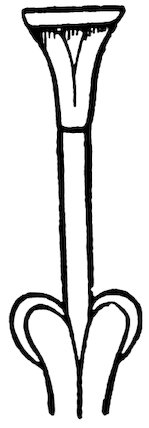
219.—Khafra.
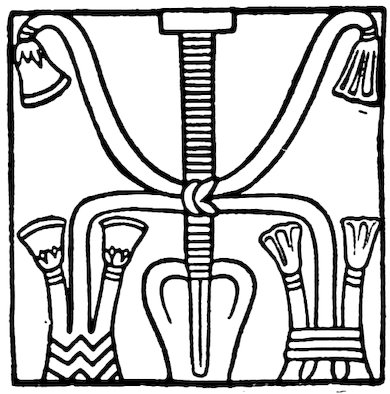
220.—Khafra.
Another hieroglyph often appearing as an ornament is the sam, or symbol of union. The origin of it is yet unexplained. It certainly is a column of some kind; it has a well-marked capital and an abacus. The capital is formed much like the palm-leaf capital; and the stem is clearly bound round, and must therefore be composite. This suggests that it might be a column of palm-sticks bound together, with some tops left projecting for ornament. Such might well be more conventionalised at the beginning of Egyptian sculpture in the IVth dynasty than the other kinds of capitals; and the immigrant race came from the region of the palm, while the lotus and papyrus only were reached by them in Egypt itself. The base is a main difficulty to explain. It might be conventionalised clods of earth, with two curled-over side branches of the palm; but it has been so modified that we must await more evidence. In any case the stem is formed of several parts bound together, and hence it was very naturally adopted as a symbol of union. It was further grouped with two plants, the stalks of which were linked around it. It is always 121supposed that these symbolise northern and southern Egypt, and that the group means the union of all the land. Still it is yet uncertain what plants are intended to be represented, though on the throne of Tahutimes IV. they are clearly lotus and papyrus; but the evidence is too late to be of much value. This group was a favourite decoration from beginning to end of Egyptian history. At the beginning of the XIIth dynasty an addition was made by placing a figure of Hapi or the Nile on each side of the group (Tanis i. I.), each figure holding one of the two plants. As these figures were crowned, one with the sign of south the other of north, they point to the plants being emblems of the south and north also. This group with the figures is found as late as the XXth dynasty (L.D. III. 237). Another design came into fashion during the great foreign 122wars of the XVIIIth dynasty, representing two captives, one negro, one Syrian, bound back to back against the sam; thus it symbolised not only the union of upper and lower Egypt, but also of the northern and southern races outside of Egypt. Later on, four or even six such racial types are figured as bound together.
INDEX
- Amu dresses, 15
- Ankh girdle, 117
- Anthemion, 65, 72
- Assyrian lotus, 72
- Barks of gods, 83
- Basket-work screens, 14, 36, 93
- Bell capital, 76
- Bes, god of dance, 115
- Binding patterns, 103
- Birds, 87
- Boat covers, 29, 31
- Borders, spiral, 40
- „ lotus, 64
- Borrowed art, 40
- Brickwork panelling, 95
- „ curved courses, 96
- C-spirals, 34
- Calf, 87
- Captives, 84
- „ bound together, 85, 122
- „ painted on sandals, 86
- Cavetto cornice, 98
- Chain of spirals, 20
- Chequer patterns, 44
- Circles, not usual, 47
- „ not divided by six, 49
- Classes of ornament, 9
- Cobra, 107
- 124Coils, 20
- Continuous spirals, 20
- Convolvulus decoration, 81
- Cornice, palm, 98
- Dad columns, 95, 117
- Daisy, 58
- Decoration, classes of, 9
- Decorative instinct of Egyptians, 2
- Descent of patterns, 5
- Disc with spots, 60
- „ and wings, 108
- Duck, 87
- Endless spirals, 21
- Feather patterns, 50
- „ types of, 51
- „ belts, 52
- Fleur-de-lys type, 68
- Flower ornament, 55
- Framing of wood, 94
- Fret patterns, 35
- „ Greek, 36, 43
- Garlands, 82
- Geometrical ornament, 9, 12
- Girdles ankh and thet, 117
- Globe and wings, 108
- Graining of wood, 89
- Grape pendants, 80
- Greek fret, 36, 43
- „ lotus, 72
- „ architecture, structural, 91
- 125Guilloche, 40
- Hathor head, 114
- „ capitals, 115
- Hawk, 87
- Hexagon pattern, 14
- Hieroglyphs decorative, 3
- „ symbolic, 116
- Hooks, 20
- Horns, 110
- Ibex, 87
- Imitation of wood, 89
- „ stone, 89
- Isiemkheb, tent of, 56, 87
- Kahun, guilloche at, 41
- Keft dresses, 15
- Khaker pattern, 100
- Khufu, 108
- Lachish, slabs, 100
- Leatherwork, 56, 59
- „ rosettes, 57
- Line decoration, 12
- „ zigzag, 13
- Links, 20
- Lion, 113
- Lotus patterns, 61
- „ tied, 62
- „ capitals, 63
- „ border, 64
- „ plant, 66
- 126„ friezes, 67
- „ flower developed, 70
- „ flower with pendants, 73
- „ column, 76
- Maat goddess, 114
- Maeander, 40
- Minusinsk art, 7
- Mykenaean spirals, 38
- „ borrowed art, 40
- „ ox head, 59
- „ disc and spots, 60
- Natural ornament, 10, 50
- Network patterns, 46
- Nile figures, 121
- Orchomenos, 39
- Origin of patterns, 5
- Ornament, classes of, 9
- Palm capital, 78
- „ not common, 79
- „ cornice, 98
- „ column, 120
- Palmetto, 65
- Panelled pattern, 95
- Papyrus, 61, 75
- „ cornice, 101
- Patterns not re-invented, 8
- Pectorals, 83
- Perspective, Egyptian, 69
- Plaiting patterns, 14, 36, 44
- 127Ra, creator, preserver and destroyer, 111
- Roll on buildings, 97, 103
- Rope borders, 42
- „ pattern, 92
- Rosette, 56, 58
- Rushwork plaiting, 14, 36, 93
- Sam column, 119
- Scale pattern really feathers, 52
- Scarab spirals, 18
- „ symbolical, 112
- Scroll pattern, 17
- Siloam tomb, 100
- Sloping faces of buildings, 96
- Spiral or scroll, 17
- „ origin of, 18
- „ sole patterns, 24
- „ earlier on scarabs, 28
- „ surface decoration, 29
- „ with lotus, 30
- „ crossed lines, 31
- „ quadruple, 31
- „ quintuple, 34
- „ developed to fret, 36
- „ late, 23
- Subdivisions.
- „ coils, 20, 21, 23, 24, 29, 40
- „ hooks, 19, 20, 22
- „ links, 19, 20, 21, 29, 42
- „ chain, 20, 21
- „ continuous, 20, 25
- „ endless, 21, 23
- 128„ false links, 26
- „ lop-sided, 27
- Spots, not Egyptian, 15, 60
- Star patterns, 57, 58, 88
- Stitch patterns, 43, 57
- Structural ornament, 10, 91
- Styles, characteristic, 8
- Symbolic ornament, 11, 106
- Tell el Amarna, 29, 54, 55, 58, 71, 75, 80, 87, 116
- Terms for spirals, 20
- Thet girdle, 117
- Thistle decoration, 82
- Torus, origin of, 97
- Uas sceptre, 117
- Uraeus, 107
- V pattern, 55
- Vine patterns, 79
- Vulture, 87, 111
- Wave borders, 41
- Wavy line, rounded, 16
- Weaving patterns, 14
- Wings symbol of protection, 109
- Wood, imitation of, 89
- Wooden framing, 94
- Wreaths, 83
- Zigzag lines, 13
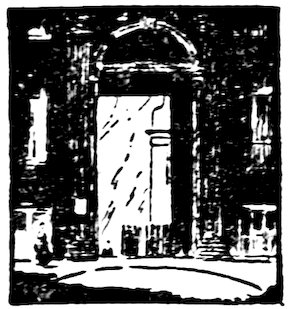
- ARMSTRONG (Anthony) (‘A. A.’ of Punch)
- Warriors at Ease
- Warriors Still at Ease
- Percival and I
- Percival at Play
- Me and Frances
- How to do It Each 3s. 6d. net.
- Livestock in Barracks
- Illustrated by E. H. SHEPARD. 6s. net.
- Two Legs and Four
- Illustrated by René Bull. 5s. net.
- BAIN (F. W.)
- A Digit of the Moon
- The Descent of the Sun
- A Heifer of the Dawn
- In the Great God’s Hair
- A Draught of the Blue
- An Essence of the Dusk
- An Incarnation of the Snow
- A Mine of Faults
- The Ashes of a God
- Bubbles of the Foam
- A Syrup of the Bees
- The Livery of Eve
- The Substance of a Dream Each 3s. 6d. net.
- An Echo of the Spheres 10s. 6d. net.
- BALFOUR (Sir Graham)
- The Life of Robert Louis Stevenson Twentieth Edition. 7s. 6d. net.
- BARKER (Ernest)
- National Character 10s. 6d. net.
- Greek Political Theory 14s. net.
- Church, State and Study 10s. 6d. net.
- BELLOC (Hilaire)
- Paris 8s. 6d. net.
- The Pyrenees 8s. 6d. net.
- Marie Antoinette 18s. net.
- A History of England
- In 5 Vols. Vols. I, II and III Each 15s. net.
- On Nothing
- Hills and the Sea
- On Something
- This and That and the Other
- On
- First and Last
- On Everything
- On Anything
- Emmanuel Burden
- A Picked Company Each 3s. 6d. net.
- BIRMINGHAM (George A.)
- A Wayfarer in Hungary
- Illustrated. 8s. 6d. net.
- Spillikins: Essays 3s. 6d. net.
- Ships and Sealing-Wax: Essays 3s. 6d. net.
- A Wayfarer in Hungary
- BLEEK (Dorothea F.)
- Rock Paintings in South Africa
- Illustrated. £2 2s. net.
- Rock Paintings in South Africa
- BUDGE (Sir E. A. Wallis)
- A History of Ethiopia: Nubia and Abyssinia
- Illustrated. 2 vols. £3 13s. 6d. net.
- A History of Ethiopia: Nubia and Abyssinia
- CHESTERTON (G. K.)
- Come to Think of It ... 6s. net.
- G.K.C. as M.C. 7s. 6d. net.
- The Ballad of the White Horse 3s. 6d. net.
- Also Illustrated by Robert Austin. 12s. 6d. net.
- Charles Dickens
- Generally Speaking
- All Things Considered
- Tremendous Trifles
- Fancies versus Fads
- Alarms and Discursions
- A Miscellany of Men
- The Uses of Diversity
- The Outline of Sanity
- The Flying Inn Each 3s. 6d. net.
- A Gleaming Cohort 2s. 6d. net.
- Wine, Water and Song 1s. 6d. net.
- CLUTTON-BROCK (A.)
- What is the Kingdom of Heaven?
- Essays on Art
- Shakespeare’s Hamlet Each 5s. net.
- Essays on Books 3s. 6d. net.
- More Essays on Books
- Essays on Life
- Essays on Religion
- Essays on Literature and Life
- More Essays on Religion Each 6s. net.
- Shelley, the Man and the Poet 7s. 6d. net.
- CRAWLEY (Ernest)
- The Mystic Rose
- Revised and Enlarged by Theodore Besterman. 2 vols. £1 10s. net.
- Studies of Savages and Sex
- Edited by Theodore Besterman. 10s. 6d. net.
- The Mystic Rose
- DAVIS (H. W. C.)
- Europe from 800–1789 8s. 6d. net.
- DERWENT (Lord)
- Goya
- Illustrated. 10s. 6d. net.
- Goya
- DUGDALE (E. T. S.)
- German Diplomatic Documents, 1871–1914
- Selected from the Documents published by the German Foreign Office.
- In 4 vols. Vol. I, 1871–90. Vol. II, 1891–8. Vol. III, 1898–1910. Vol. IV, 1911–1914. Each £1 1s. net.
- German Diplomatic Documents, 1871–1914
- EDWARDES (Tickner)
- The Lore of the Honey-Bee
- Illustrated. 7s. 6d. and 3s. 6d. net.
- Beekeeping for All
- Illustrated. 3s. 6d. net.
- The Bee-Master of Warrilow
- Illustrated. 7s. 6d. net.
- Bee-Keeping Do’s and Dont’s 2s. 6d. net.
- The Lore of the Honey-Bee
- EINSTEIN (Albert)
- Relativity: The Special and General Theory 5s. net.
- Sidelights on Relativity 3s. 6d. net.
- The Meaning of Relativity 5s. net.
- The Brownian Movement 5s. net.
- EISLER (Robert)
- The Messiah Jesus and John the Baptist:
- according to Flavius Josephus’ hitherto neglected ‘Capture of Jerusalem’ and other Jewish and Christian sources.
- Translated by A. Haggerty Krappe.
- Illustrated. Demy 8vo. £2 2s. net.
- The Messiah Jesus and John the Baptist:
- FIELD (G. C.)
- Moral Theory 6s. net.
- Plato and His Contemporaries 12s. 6d. net.
- FYLEMAN (Rose)
- Fairies and Chimneys
- The Fairy Green
- The Fairy Flute
- The Rainbow Cat
- Eight Little Plays for Children
- Forty Good-night Tales
- Fairies and Friends
- The Adventure Club
- Forty Good-Morning Tales
- Seven Little Plays for Children
- Twenty Tea-Time Tales Each 3s. 6d. net.
- The Dolls’ House
- Illustrated by Margaret Tempest. 5s. net.
- Gay Go Up
- Illustrated by Decie Merwin. 5s. net.
- The Rose Fyleman Fairy Book
- Illustrated by Hilda Miller. 10s. 6d. net.
- A Garland of Rose’s: Collected Poems
- Illustrated by René Bull. 8s. 6d. net.
- GIBBON (Edward)
- The Decline and Fall of the Roman Empire With Notes, Appendixes and Maps, by J. B. Bury.
- Illustrated. 7 vols.
- Demy 8vo. 15s. net each volume.
- Also, unillustrated. Crown 8vo. 7s. 6d. net each volume.
- Illustrated. 7 vols.
- The Decline and Fall of the Roman Empire With Notes, Appendixes and Maps, by J. B. Bury.
- GLADSTONE (Mary) (Mrs. Drew)
- Her Diaries and Letters
- Illustrated. £1 1s. net.
- Her Diaries and Letters
- GLOVER (T. R.)
- Virgil
- The Conflict of Religions in the Early Roman Empire
- Poets and Puritans Each 10s. 6d. net.
- From Pericles to Philip 12s. 6d. net.
- GRAHAM (Harry)
- The World we Laugh in: More Deportmental Ditties
- Illustrated by ‘Fish’. Seventh Edition. 5s. net.
- Strained Relations
- Illustrated by H. Stuart Menzies and Hendy 6s. net.
- The World’s Workers
- Illustrated by ‘Fougasse’. 5s. net.
- Adam’s Apples
- Illustrated by John Reynolds. 5s. net.
- The World we Laugh in: More Deportmental Ditties
- GRAHAME (Kenneth)
- The Wind in the Willows
- Nineteenth Edition. 7s. 6d. net.
- Also illustrated by Wyndham Payne. 7s. 6d. net.
- Also unillustrated. 3s. 6d. net.
- Nineteenth Edition. 7s. 6d. net.
- See also Milne (A. A.)
- The Wind in the Willows
- HADFIELD (J. A.)
- Psychology and Morals
- Eighth Edition. Crown 8vo. 6s. net.
- Psychology and Morals
- HALL (H. R.)
- The Ancient History of the Near East
- Illustrated. £1 1s. net.
- The Civilization of Greece in the Bronze Age
- Illustrated. £1 10s. net.
- A Season’s Work at Ur of the Chaldees.
- Illustrated. £1 5s. net.
- The Ancient History of the Near East
- HEATON (Rose Henniker)
- The Perfect Hostess
- Decorated by A. E. Taylor 7s. 6d. net.
- Gift Edition, £1 1s. net.
- The Perfect Hostess
- HERBERT (A. P.)
- Honeybubble & Co. 6s. net.
- Misleading Cases in the Common Law. With an Introduction by Lord Hewart. 5s. net.
- More Misleading Cases. 5s. net.
- Wisdom for the Wise
- Illustrated by George Morrow. 5s. net.
- The Wherefore and the Why
- Illustrated by George Morrow. 3s. 6d. net.
- The Bomber Gipsy 3s. 6d. net.
- The Secret Battle 3s. 6d. net.
- HOLDSWORTH (Sir W. S.)
- A History of English Law Nine Volumes. £1 5s. net each.
- HUDSON (W. H.)
- A Shepherd’s Life
- Illustrated. 10s. 6d. net.
- Also unillustrated. 3s. 6d. net.
- A Shepherd’s Life
- HUTTON (Edward)
- Cities of Sicily
- Illustrated. 10s. 6d. net.
- Milan and Lombardy
- The Cities of Romagna and the Marches
- Siena and Southern Tuscany
- Naples and Southern Italy
- Illustrated. Each 8s. 6d. net.
- A Wayfarer in Unknown Tuscany
- The Cities of Spain
- The Cities of Umbria
- Country Walks about Florence
- Rome
- Florence and Northern Tuscany
- Venice and Venetia
- Illustrated. Each 7s. 6d. net.
- Cities of Sicily
- INGE (W. R.), D.D., Dean of St. Paul’s
- Christian Mysticism (The Bampton Lectures of 1899).
- Sixth Edition. 7s. 6d. net.
- Christian Mysticism (The Bampton Lectures of 1899).
- KIPLING (Rudyard)
- Barrack-Room Ballads
- 255th Thousand.
- The Seven Seas
- 186th Thousand.
- The Five Nations
- 143rd Thousand.
- Departmental Ditties
- 117th Thousand.
- The Years Between
- 95th Thousand.
- Four Editions of these famous-volumes of poems are now published, viz.:—
- Crown 8vo. Buckram, 7s. 6d. net.
- Fcap. 8vo. Cloth, 6s. net.
- Leather 7s. 6d. net.
- Service Edition. Two volumes each book. Square Fcap. 8vo. 3s. net each volume.
- A Kipling Anthology—Verse
- Sixth Edition.
- Leather 7s. 6d. net.
- Cloth 6s. net and 3s. 6d. net.
- Twenty Poems from Rudyard Kipling
- 486th Thousand. 1s. net.
- A Choice of Songs
- Second Edition. 2s. net.
- Barrack-Room Ballads
- LAMB (Charles and Mary)
- The Complete Works
- Edited by E. V. Lucas. Six Volumes. With Frontispieces. 6s. net each.
- Selected Letters
- Edited by G. T. Clapton. 3s. 6d. net.
- The Charles Lamb Day Book
- Compiled by E. V. Lucas. 6s. net.
- The Complete Works
- LANKESTER (Sir Ray)
- Science from an Easy Chair
- Science from an Easy Chair:
- Second Series.
- Diversions of a Naturalist
- Great and Small Things
- Illustrated. Each 7s. 6d. net.
- Secrets of Earth and Sea
- Illustrated. 8s. 6d. net.
- LINDRUM (Walter)
- Billiards.
- Illustrated. 6s. net.
- Billiards.
- LODGE (Sir Oliver)
- Man and the Universe 7s. 6d. net and 3s. 6d. net.
- The Survival of Man 7s. 6d. net.
- Raymond 10s. 6d. net.
- Raymond Revised 6s. net.
- Modern Problems 3s. 6d. net.
- Reason and Belief 3s. 6d. net.
- The Substance of Faith 2s. net.
- Relativity 1s. net.
- Conviction of Survival 2s. net.
- LUCAS (E. V.)
- The Life of Charles Lamb
- 2 Vols. £1 1s. net.
- The Colvins and Their Friends £1 1s. net.
- Vermeer the Magical 5s. net.
- A Wanderer in Rome
- A Wanderer in Holland
- A Wanderer in London
- London Revisited (Revised)
- A Wanderer in Paris
- A Wanderer in Florence
- A Wanderer in Venice Each 10s. 6d. net.
- A Wanderer among Pictures 8s. 6d. net.
- E. V. Lucas’s London £1 net.
- Introducing London
- Introducing Paris Each 2s. 6d. net.
- The Open Road 6s. net.
- Also, illustrated by Claude A. Shepperson, A.R.W.S. 10s. 6d. net.
- Also, India Paper. Leather, 7s. 6d. net.
- The Joy of Life 6s. net. Leather Edition, 7s. 6d. net.
- Also, India Paper. Leather, 7s. 6d. net.
- The Gentlest Art 6s. 6d. net.
- And The Second Post 6s. net.
- Also together in one volume. 7s. 6d. net.
- Fireside and Sunshine
- Character and Comedy
- Good Company
- One Day and Another
- Old Lamps for New
- Loiterer’s Harvest
- Luck of the Year
- Events and Embroideries
- A Fronded Isle
- A Rover I Would Be
- Giving and Receiving
- Her Infinite Variety
- Encounters and Diversions Each 3s. 6d. net.
- Cloud and Silver
- A Boswell of Baghdad
- ’Twixt Eagle and Dove
- The Phantom Journal
- Zigzags in France
- Turning Things Over
- Traveller’s Luck Each 6s. net.
- French Leaves
- Illustrated. 5s. net.
- Roving East and Roving West 5s. net.
- Mr. Punch’s County Songs
- Illustrated by E. H. Shepard. 10s. 6d. net.
- ‘The More I See of Men ...’
- Out of a Clear Sky
- If Dogs Could Write
- ‘... and such Small Deer’ Each 3s. 6d. net.
- The Pekinese National Anthem
- Illustrated by Persis Kirmse. 1s. net.
- See also Lamb (Charles).
- The Life of Charles Lamb
- LYND (Robert)
- It’s A Fine World 5s. net.
- The Green Man
- The Pleasures of Ignorance
- The Goldfish
- The Little Angel
- The Blue Lion
- The Peal of Bells
- The Money-Box
- The Orange Tree Each 3s. 6d. net.
- McDOUGALL (William)
- An Introduction to Social Psychology 10s. 6d. net.
- National Welfare and National Decay 6s. net.
- An Outline of Psychology 10s. 6d. net.
- An Outline of Abnormal Psychology 15s. net.
- Body and Mind 12s. 6d. net.
- Character and the Conduct of Life 10s. 6d. net.
- Modern Materialism and Emergent Evolution 7s. 6d. net.
- Ethics and Some Modern World Problems 7s. 6d. net.
- MALLET (Sir C. E.)
- A History of the University of Oxford
- In 3 vols. Each £1 1s. net.
- A History of the University of Oxford
- MAETERLINCK (Maurice)
- The Blue Bird 6s. net.
- Also, illustrated by F. Cayley Robinson. 10s. 6d. net.
- Our Eternity 6s. net.
- The Unknown Guest 6s. net.
- Poems 5s. net.
- The Wrack of the Storm 6s. net.
- The Burgomaster of Stilemonde 5s. net.
- The Betrothal 6s. net.
- Mountain Paths 6s. net.
- The Great Secret 7s. 6d. net.
- The Cloud that Lifted and The Power of the Dead 7s. 6d. net.
- Mary Magdalene 2s. net.
- The Blue Bird 6s. net.
- MARLOWE (Christopher)
- The Works. In 6 volumes. General Editor, R. H. Case.
- The Life of Marlowe, by C. F. Tucker Brooke, and Dido.
- Edited by the Same. 8s. 6d. net.
- Tamburlaine, I and II.
- Edited by U. M. Ellis-Fermor. 10s. 6d. net.
- The Jew of Malta and The Massacre at Paris
- Edited by H. S. Bennett. 8s. 6d. net.
- The Life of Marlowe, by C. F. Tucker Brooke, and Dido.
- The Works. In 6 volumes. General Editor, R. H. Case.
- MASEFIELD (John)
- On the Spanish Main 8s. 6d. net.
- A Sailor’s Garland 3s. 6d. net.
- Sea Life in Nelson’s Time 7s. 6d. net.
- METHUEN (Sir A.)
- An Anthology of Modern Verse
- 232nd Thousand.
- Shakespeare to Hardy: An Anthology of English Lyrics
- 28th Thousand.
- Each, Cloth, 6s. net.
- Leather, 7s. 6d. net.
- 28th Thousand.
- An Anthology of Modern Verse
- MILNE (A. A.)
- By Way of Introduction 6s. net.
- Toad of Toad Hall
- A Play founded on Kenneth Grahame’s ‘The Wind in the Willows.’ 5s. net and 2s. 6d. net.
- Those Were the Days: Collected Stories 7s. 6d. net.
- Not that it Matters
- If I May
- The Sunny Side
- The Red House Mystery
- Once a Week
- The Holiday Round
- The Day’s Play
- Mr. Pim Passes By Each 3s. 6d. net.
- When We were Very Young
- 211th Thousand.
- Winnie-the-Pooh
- 118th Thousand.
- Now We are Six
- 119th Thousand.
- The House at Pooh Corner
- 105th Thousand.
- Each illustrated by E. H. SHEPARD. 7s. 6d. net. Leather, 10s. 6d. net.
- The Christopher Robin Story Book. Third Edition.
- Illustrated by E. H. SHEPARD. 5s. net.
- The Christopher Robin Birthday Book
- Illustrated by E. H. SHEPARD. 3s. 6d. net.
- MILNE (A. A.) and FRASER-SIMSON (H.)
- Fourteen Songs from ‘When We were Very Young’
- Thirteenth Edition. 7s. 6d. net.
- Teddy Bear and Other Songs from ‘When We were Very Young’ 7s. 6d. net.
- The King’s Breakfast
- Third Edition. 3s. 6d. net.
- Songs from ‘Now We are Six’
- Second Edition. 7s. 6d. net.
- More ‘Very Young’ Songs 7s. 6d. net.
- The Hums of Pooh 7s. 6d. net.
- Words by A. A. Milne.
- Music by H. Fraser-Simson.
- Decorations by E. H. Shepard.
- Fourteen Songs from ‘When We were Very Young’
- MORTON (H. V.)
- The Heart of London
- 27th Thousand. 3s. 6d. net.
- Also with Scissor Cuts by L. Hummel. 6s. net.
- The Spell of London
- 20th Thousand.
- The Nights of London
- 13th Thousand. Each 3s. 6d. net.
- In Search of England
- 64th Thousand.
- The Call of England
- 31st Thousand.
- In Search of Scotland
- 86th Thousand.
- In Search of Ireland
- 30th Thousand. Each illustrated. 7s. 6d. net.
- The Soul of Scotland 1s. net.
- The Heart of London
- NEUBURGER (Albert)
- The Technical Arts and Sciences of the Ancients
- Translated by H. L. Brose.
- Illustrated. £2 2s. net.
- The Technical Arts and Sciences of the Ancients
- OMAN (Sir Charles)
- A History of the Art of War in the Middle Ages, a.d. 378–1485
- 2 vols. Illustrated. £1 16s. net.
- Studies in the Napoleonic Wars 8s. 6d. net.
- A History of the Art of War in the Middle Ages, a.d. 378–1485
- PERRY (W. J.)
- The Origin of Magic and Religion
- The Growth of Civilization Each 6s. net.
- The Children of the Sun £1 1s. net.
- PETRIE (Sir Flinders)
- A History of Egypt
- In 6 Volumes.
- Vol. I. From the Ist to the XVIth Dynasty
- Eleventh Edition, Revised. 12s. net.
- Vol. II. The XVIIth and XVIIIth Dynasties
- Seventh Edition, Revised. 9s. net.
- Vol. III. XIXth to XXXth Dynasties
- Third Edition. 12s. net.
- Vol. IV. Egypt under the Ptolemaic Dynasty
- By Edwyn Bevan. 15s. net.
- Vol. V. Egypt under Roman Rule
- By J. G. Milne.
- Third Edition, Revised. 12s. net.
- Vol. VI. Egypt in the Middle Ages
- By Stanley Lane Poole.
- Fourth Edition. 10s. net.
- A History of Egypt
- PONSONBY OF SHULBREDE (Lord)
- English Diaries £1 1s. net.
- More English Diaries 12s. 6d. net.
- Scottish and Irish Diaries 10s. 6d. net.
- RUTTER (Frank)
- El Greco. Illustrated. £1 16s. net.
- SELLAR (W. C.) and YEATMAN (R. J.)
- 1066 and All That
- Illustrated by John Reynolds.
- 32nd Thousand. 5s. net.
- 1066 and All That
- STEVENSON (R. L.)
- The Letters Edited by Sir Sidney Colvin. 4 Vols. Each 6s. net.
- SURTEES (R. S.)
- Handley Cross
- Mr. Sponge’s Sporting Tour
- Ask Mamma
- Mr. Facey Romford’s Hounds
- Plain or Ringlets?
- Hillingdon Hall Each illustrated. 7s. 6d. net.
- Jorrocks’s Jaunts and Jollities
- Hawbuck Grange Each illustrated. 6s. net.
- TAYLOR (A. E.)
- Plato: The Man and His Work £1 1s. net.
- Plato: Timæus and Critias 6s. net.
- Elements of Metaphysics 12s. 6d. net.
- TILDEN (William T.)
- The Art of Lawn Tennis
- Revised Edition
- Singles and Doubles Each illustrated. 6s. net.
- The Common Sense of Lawn Tennis
- Match Play and the Spin of the Ball Each illustrated. 5s. net.
- The Art of Lawn Tennis
- TILESTON (Mary W.)
- Daily Strength for Daily Needs
- Thirty-fourth Edition. 3s. 6d. net.
- India Paper. Leather, 6s. net.
- Daily Strength for Daily Needs
- TRAPP (Oswald Graf)
- The Armoury of the Castle of Churburg
- Translated by J. G. Mann.
- Richly illustrated.
- Limited to 400 copies. £4 14s. 6d. net.
- The Armoury of the Castle of Churburg
- UNDERHILL (Evelyn)
- Mysticism. Revised Edition. 15s. net.
- The Life of the Spirit and the Life of To-day 7s. 6d. net.
- Man and the Supernatural 7s. 6d. net.
- Concerning the Inner Life 2s. net.
- The House of the Soul 2s. net.
- VARDON (Harry)
- How to Play Golf
- Illustrated. Nineteenth Edition. 5s. net.
- How to Play Golf
- WAND (J. W. C.)
- The Development of Sacramentalism 6s. net.
- A History of the Modern Church 8s. 6d. net.
- WILDE (Oscar)
- The Works
- In 16 Vols. Each 6s. 6d. net.
- I. Lord Arthur Savile’s Crime and the Portrait of Mr. W. H.
- II. The Duchess of Padua
- III. Poems
- IV. Lady Windermere’s Fan
- V. A Woman of No Importance
- VI. An Ideal Husband
- VII. The Importance of Being Earnest
- VIII. A House of Pomegranates
- IX. Intentions
- X. De Profundis and Prison Letters
- XI. Essays
- XII. Salome, A Florentine Tragedy, and La Sainte Courtisane
- XIV. Selected Prose of Oscar Wilde
- XV. Art and Decoration
- XVI. For Love of the King 5s. net.
- XVII. Vera, or the Nihilists
- The Works
- WILLIAMSON (G. C.)
- The Book of Famille Rose
- Richly Illustrated. £8 8s. net.
- The Book of Famille Rose

